A New Decision-Making Strategy for Techno-Economic Assessment of Generation and Transmission Expansion Planning for Modern Power Systems
Abstract
1. Introduction
- A G&TNEP model that compares various project types in order to maximize the HC is rarely presented in the literature. Most existing models allow for integrating a single type of project for each planned project. Several case studies should be implemented to assess each class separately.
- The implementation of mathematical methods may increase the computational burden. Thus, a linearization approach is essential to deal with non-linear equations and avoid trapping at local optimums.
- Although the hybrid of meta-heuristic algorithms is more effective in solving the G&TNEP problem compared to non-hybrid algorithms, the performance of these algorithms degrades if several types of projects are planned simultaneously. The number of decision variables and the search space increase proportionately with the number of projects designed.
- 1.
- Planning models of RESs, ESSs, TCSCs, FCLs, and SVCs are integrated into the G&TNEP to enhance the planning process and achieve the technical requirements. These projects give the system operator more options for improving the system security and lowering planning costs.
- 2.
- A HC planning model with a reduced search space is investigated to compare many types of RESs, FACTs and ESSs and to select the most suitable, technically and economically.
- 3.
- A decision-making approach is suggested to decrease the problem’s complexity. Four schemes are proposed to reduce the number of decision-making variables.
- 4.
- An improved war strategy optimizer based on the Runge-Kutta learning strategy is proposed to solve the problem.

2. Problem Formulation
2.1. Objective Function
2.2. Problem Constraints
2.2.1. Project Constraints
2.2.2. Power Flow Constraints
2.2.3. Capabilities Constraints of ESSs, SVCs, and Generation Units
2.2.4. Hosting Capacity Constraint
2.2.5. Short-Circuit Current Constraints
3. Proposed Decision-Making Approach
3.1. Planning Scheme for New Circuits and TCSCs
| Algorithm 1: Pseudo-code of circuits and TCSCs planning scheme. |
| 1: Inputs: the maximum compensation level and . 2: For. 3: Calculate the number of new circuits required using: ) using (59). 4: < 4 |
| 5: 6: end 7: Calculate the number of new circuits required using: 8: Calculate using (61). 9: Calculate the compensation level required in each route ) using (62). 10: end |
3.2. Planning Scheme for ESSs
- 1.
- First path: All types meetIn this case, the planning cost is calculated for each type, and the type that provides the lowest installation cost is selected.
- 2.
- Second path: One or more types cannot meetIn this case, the sources that meet are selected for comparison, and the type that provides the lowest installation cost is determined. The types that fail to achieve are excluded.
- 3.
- Third path: All types cannot meetIn this case, the preferred type is first assigned with the highest priority to compensate . It is the type selected in the first scenario. The preferred type’s sharing level is then calculated (), which equals its maximum power depending on the operating mode (charging mode or discharging mode). After that, the sharing levels of the other types are calculated using (65).
| Algorithm 2: Pseudo-code of ESSs planning scheme. |
| 1:
Inputs: , and the vector of required power injected or absorbed from or by ESSs (). 2: For 3: Define the preferred ESS that has the priority to compensate . 4: For each ESS type 5: If 6: = |
| 7: else 8: Define . 9: Calculate using (65). 10: end 11: Calculate the cost of ESS installed. 12: end 13: If for all types equals 14: The selected ESS is the type that has the lowest investment and operation cost. 15: 16: else 17: Define . 18: Find types of 19: If all types except the preferred type meet 18 Select the type that has the highest to integrate with . 20: else 21: Select types that do not meet 18 22: Select the ESS type with the lowest cost to integrate with the preferred type. 23: end 24: Define the power shared by the selected ESS ) 25: 26: end 27: Update SOC of selected types. 28: end |
3.3. Planning Scheme for Reactive Power Sources
| Algorithm 3: Pseudo-code of VAR planning scheme. |
| 1: Inputs: the maximum charging and discharging reactive power for each ESS type ), and required power injected or absorbed from or by SVCs and ESSs () 2: Reactive powers shared by ESSs are determined using the same steps in Algorithm 2. 3: For 4: Calculate the planning cost of VAR and selected ESSs. 5: If 6: A type that has the lowest cost is selected. |
| 7: else 8: If= 9: The selected type is SVC. 10: else If= 11: The selected type is ESS. 12: else 13: Define the preferred source regarding the source selected in the first scenario (). 14: Calculate the required capacity of the other type: 15: Calculate the planning cost of SVC and selected ESS. 16: end 17: end 18: end |
3.4. Planning Scheme for RESs
- 1.
- First path: The rated values needed of all types are lower than or equal to their maximum.In this case, the sharing level of each type is equal to the , and the type that provides the lowest installation cost is selected.
- 2.
- Second path: The rated values of one or more types exceed the maximum.In this case, the types that fail to supply the required power are excluded, and the types that meet are compared in terms of installation cost to select the suitable type.
- 3.
- Third path: The rated values of all types exceed the maximum.In this case, the sharing level for the type that has the priority to inject power into the grid and is calculated using (70) or (71), considering its maximum power. Similar to ESSs planning, this source is the type selected in the first scenario. The sharing level of the other types ( is obtained as follows:
| Algorithm 4: Pseudo-code of RESs planning scheme. |
| Inputs: and . 1: FOR 2: Define the RES that has the priority to inject . 3: Calculate and using (72) and (73) considering the output 4: If and 5: Select the RES with the lowest cost. |
| 6: end 7: If or 8: Exclude this type. 9: end 10: If and 11: Calculate using (70) or (71). 12: Calculate using (74). 13: Calculate the planning cost for types that meet (74). 14: Select the type with the lowest cost to incorporate with the preferred type 15: end 16: end |
4. Algorithm Preliminaries
4.1. War Strategy Optimization Algorithm
4.2. Runge-Kutta Optimization Algorithm
4.3. RKWSO
- (a)
- In each iteration:
- The RKWSO solver optimally updates the location of the new transmission lines, and the size of the FCL modules, FACTs, ESSs, and RESs.
- Apply the proposed decision-making approach to define each project type.
- Check the normal operation constraints (18)–(22) and (24)–(55).
- Apply a three-phase short-circuit fault and check the short-circuit constraint (18) and (57).
- Add a high penalty cost to solutions that violate the problem constraints.
- Repeat the above steps until the maximum number of iterations is reached.
- (b)
- Repeat step (a) until the maximum number of runs is reached.
- (c)
- Determine the best solution by comparing the results of each run.
- (d)
- Update the lower bound of the decision-making variables.
- (e)
- Go to the next scenario.
5. Numerical Results
5.1. Test Systems
5.2. Garver Network
5.2.1. Validation of the Proposed Solution Method
5.2.2. Technical and Economic Analysis
5.2.3. Testing the Efficiency of RKWSO
5.3. IEEE 118-Bus System
5.3.1. Validation of the Proposed Solution Method
5.3.2. Technical and Economic Analysis
5.3.3. Testing the Efficiency of RKWSO
5.4. Discussion
6. Conclusions
- The reliance on the reactance of the transmission lines efficiently determined the location and quantity of the new circuits required. It was more robust than the conventional method. Furthermore, the first scheme helped the RKWSO optimally plan circuits and TCSCs simultaneously without increasing the search space. The proposed RKWSO-based approach was superior in terms of the best solution gained, the SD, and the robustness measurement. Considering the transmission line reactance as a new control variable facilitates the planning of many devices that directly affect the impedance of the lines without impacting the number of decision-making variables or affecting the performance of the meta-heuristic algorithm.
- The second scheme effectively controlled the charging and discharging powers of PHS and Li-ion without affecting the performance of the RKWSO. Many types of ESSs can be efficiently planned and compared. The PHS was economically preferable to the Li-ion. The optimal mix of both was essential for the 118-bus system under the cases studied in this work. The use of ESSs was necessary only when the output of the thermal units was not enough to supply the loads. Given the ability of the ESSs to absorb the reactive power, the required capacity of the ESSs was reduced, as was the planning cost. The use of many ESS types is essential in some networks for improving the networks’ performance during steady state and contingencies.
- Incorporating the planning model of SVCs through the third scheme into the co-planning model did not affect the number of control variables or the efficiency of the solver. The SVCs were economically more suitable than the ESSs for injecting reactive power for long-term planning.
- The fourth scheme succeeded in controlling the HC of many RESs without degrading the performance of the meta-heuristic algorithms. The wind farms were technically and economically preferred to the PV systems. The planning cost of the RES is high and should be ignored in the hope of increasing the HC and mitigating climate change.
- The effectiveness of the proposed decision-making approach was tested through the RKWSO, SO, WSO, SCA, and RUN. The results showed an improvement in the performance of all the algorithms after applying the proposed approach. By adding the proposed decision-making approach, the convergence time of all the algorithms was found to be faster.
- The RKWSO was superior to SO, WSO, SCA, and RUN in terms of the SD, the robustness measurement, and the mean. The use of a combination of many meta-heuristic algorithms is more effective in solving this type of problem than a single algorithm.
Author Contributions
Funding
Data Availability Statement
Conflicts of Interest
Nomenclature
| Indices and set for buses | |
| Index and set for ESSs | |
| Index and set for FCLs | |
| Index and set for generators | |
| Index and set for scenarios | |
| Index and set for types of ESSs | |
| Index and set for transmission lines | |
| Set for generators, transmission lines, and ESSs connected to bus i | |
| Index and set for types of RESs | |
| Index and set for the number of replacements for ESS of type k | |
| Index and set for SVCs | |
| Index and set for SVCs | |
| Period until the replacement for ESS b of type k | |
| Susceptance of the route between bus i and j | |
| Market energy price for ESS of type k (millions USD/MWh) | |
| Natural gas cost per gas unit for ESS of type k | |
| Replacement cost coefficient for ESS b of type k (millions USD/MWh) | |
| Investment cost of thermal, wind, and PV stations, respectively | |
| Variable operating cost of thermal, wind, and PV stations, respectively | |
| Fixed operating cost of thermal, wind, and PV stations, respectively | |
| Cost and revenue of CCSS built for thermal unit g (million USD/metric tonne) | |
| Cost of circuits installed between bus i and bus j | |
| Storage container cost for type k (millions USD/MWh) | |
| Power conversion and balance of plant costs for type k (millions USD/MW) | |
| Factor of the fixed operating cost for ESS of type k (millions USD/MW) | |
| Maximum depth of discharge for ESS of type k | |
| Installed capacity at hour h and rated capacity for ESS b of type k (MWh) | |
| Conductance of the route between bus i and j | |
| Rate of gas consumption for ESS of type k (MJ/kWh) | |
| Maximum number of routes in the system | |
| Number of circuits between bus i and j at hour h | |
| Required number and the maximum number for ESS of type k at hour h, respectively. | |
| Number of units for generator g installed at hour h | |
| Number of thermal, wind, and PV units for generator g installed at hour h | |
| Number of components for SVCs at hour h | |
| Number of TCSC components for the route i-j at hour h | |
| Injected and absorbed active power by BDC for ESS b of type k (MW) | |
| Maximum charging and discharging power for ESS b of type k at hour h (MW) | |
| Active power consumed by the load at bus i (MW) | |
| Vector of active power injected by RESs at hour h (MW) | |
| Vector of the maximum capacity of wind turbines (MW) | |
| Vector of the maximum capacity of PV systems (MW) | |
| Output active power of thermal, wind, and PV units at location g at hour h, respectively (MW) | |
| Required power and rated power for ESS b of type k at hour h (MW) | |
| Vector of calculated ESSs’ power at hour h (MW) | |
| Power losses for line l connected with bus i | |
| Active power flows in the circuit i-j in both terminals at hour h and their limits (MW) | |
| Minimum active power of thermal, wind, and PV units at location g | |
| Maximum active power of thermal, wind, and PV units at location g | |
| Vector of reactive power injected by reactive sources at hour h (MVAR) | |
| Injected and absorbed reactive power by BDC for ESS b of type k (MVAR) | |
| Reactive power consumed by the load at bus i (MW) | |
| reactive power flows in the circuit i-j in both terminals at hour h and their limits (MVAR) | |
| Capacity of SVCs installed and its limits (MVAR) | |
| Output reactive power for the thermal unit g and its limits (MVA | |
| Apparent power flows in the circuit i-j in both terminals at hour h and their limits (MVA) | |
| Increment in the maximum apparent power of circuit i-j due to building a TCSC with compensation levels | |
| SOC of ESS at bus i and hour h | |
| Rate of variation of | |
| Rate of variation of the fixed operation and maintenance cost for ESS of type k | |
| Rate of variation of the gas price for ESS of type k | |
| Voltage at bus i (p.u) | |
| Initial reactance for the circuit i-j | |
| Reactance calculated of projects installed in the route i-j | |
| Compensation and needed compensation level of a TCSC installed in the circuit between bus m and bus n | |
| Voltage angle at bus i (p.u) | |
| Charging and discharging efficiencies for ESS of type k | |
| , Y | Discount rate and the lifetime of the project |
| Time interval between any two successive scenarios |
References
- Ansari, M.R.; Pirouzi, S.; Kazemi, M.; Benbouzid, M.; Naderipour, A. Renewable Generation and Transmission Expansion Planning Coordination with Energy Storage System: A Flexibility Point of View. Appl. Sci. 2021, 11, 3303. [Google Scholar] [CrossRef]
- Latvakoski, J.; Mäki, K.; Ronkainen, J.; Julku, J.; Koivusaari, J. Simulation-Based Approach for Studying the Balancing of Local Smart Grids with Electric Vehicle Batteries. Systems 2015, 3, 81–108. [Google Scholar] [CrossRef]
- Annual Energy Outlook Introduction—Key Takeaways from the Reference Case and Side Cases—U.S. Energy Information Administration (EIA). Available online: https://www.eia.gov/outlooks/aeo/narrative/introduction/sub-topic-01.php (accessed on 13 July 2022).
- Sund, L.; Talari, S. Stochastic Wind Power Generation Planning in Liberalised Electricity Markets within a Heterogeneous Landscape. Energies 2022, 15, 8109. [Google Scholar] [CrossRef]
- Xie, Y.; Xu, Y. Transmission Expansion Planning Considering Wind Power and Load Uncertainties. Energies 2022, 15, 7140. [Google Scholar] [CrossRef]
- Naderi, E.; Pourakbari-Kasmaei, M.; Lehtonen, M. Transmission Expansion Planning Integrated with Wind Farms: A Review, Comparative Study, and a Novel Profound Search Approach. Int. J. Electr. Power Energy Syst. 2020, 115, 105460. [Google Scholar] [CrossRef]
- Aschidamini, G.L.; da Cruz, G.A.; Resener, M.; Ramos, M.J.S.; Pereira, L.A.; Ferraz, B.P.; Haffner, S.; Pardalos, P.M. Expansion Planning of Power Distribution Systems Considering Reliability: A Comprehensive Review. Energies 2022, 15, 2275. [Google Scholar] [CrossRef]
- Koltsaklis, N.E.; Dagoumas, A.S. State-of-the-Art Generation Expansion Planning: A Review. Appl. Energy 2018, 230, 563–589. [Google Scholar] [CrossRef]
- Mutlu, S.; Şenyiğit, E. Literature Review of Transmission Expansion Planning Problem Test Systems: Detailed Analysis of IEEE-24. Electr. Power Syst. Res. 2021, 201, 107543. [Google Scholar] [CrossRef]
- Mahdavi, M.; Sabillon Antunez, C.; Ajalli, M.; Romero, R. Transmission Expansion Planning: Literature Review and Classification. IEEE Syst. J. 2019, 13, 3129–3140. [Google Scholar] [CrossRef]
- Esmaili, M.; Ghamsari-Yazdel, M.; Amjady, N.; Chung, C.Y. Convex Model for Controlled Islanding in Transmission Expansion Planning to Improve Frequency Stability. IEEE Trans. Power Syst. 2021, 36, 58–67. [Google Scholar] [CrossRef]
- Gjorgiev, B.; David, A.E.; Sansavini, G. Cascade-Risk-Informed Transmission Expansion Planning of AC Electric Power Systems. Electr. Power Syst. Res. 2022, 204, 107685. [Google Scholar] [CrossRef]
- Armaghani, S.; Hesami Naghshbandy, A.; Shahrtash, S.M. A Novel Multi-Stage Adaptive Transmission Network Expansion Planning to Countermeasure Cascading Failure Occurrence. Int. J. Electr. Power Energy Syst. 2020, 115, 105415. [Google Scholar] [CrossRef]
- WANG, J.; ZHONG, H.; XIA, Q.; KANG, C. Transmission Network Expansion Planning with Embedded Constraints of Short Circuit Currents and N-1 Security. J. Mod. Power Syst. Clean Energy 2015, 3, 312–320. [Google Scholar] [CrossRef]
- Refaat, M.M.; Aleem, S.H.E.; Atia, Y.; Ali, Z.M.; El-Shahat, A.; Sayed, M.M. A Mathematical Approach to Simultaneously Plan Generation and Transmission Expansion Based on Fault Current Limiters and Reliability Constraints. Mathematics 2021, 9, 2771. [Google Scholar] [CrossRef]
- Ordóñez, C.A.; Gómez-Expósito, A.; Maza-Ortega, J.M. Series Compensation of Transmission Systems: A Literature Survey. Energies 2021, 14, 1717. [Google Scholar] [CrossRef]
- Mostafa, M.H.; Abdel Aleem, S.H.E.; Ali, S.G.; Ali, Z.M.; Abdelaziz, A.Y. Techno-Economic Assessment of Energy Storage Systems Using Annualized Life Cycle Cost of Storage (LCCOS) and Levelized Cost of Energy (LCOE) Metrics. J. Energy Storage 2020, 29, 101345. [Google Scholar] [CrossRef]
- Esmaili, M.; Ghamsari-Yazdel, M.; Amjady, N.; Chung, C.Y.; Conejo, A.J. Transmission Expansion Planning Including TCSCs and SFCLs: A MINLP Approach. IEEE Trans. Power Syst. 2020, 35, 4396–4407. [Google Scholar] [CrossRef]
- Mehrtash, M.; Cao, Y. A New Global Solver for Transmission Expansion Planning with AC Network Model. IEEE Trans. Power Syst. 2022, 37, 282–293. [Google Scholar] [CrossRef]
- Bhattiprolu, P.A.; Conejo, A.J. Multi-Period AC/DC Transmission Expansion Planning Including Shunt Compensation. IEEE Trans. Power Syst. 2022, 37, 2164–2176. [Google Scholar] [CrossRef]
- Mahfoud, S.; Derouich, A.; Ouanjli, N.E.L.; Mahfoud, M.E.L.; Taoussi, M. A New Strategy-Based Pid Controller Optimized by Genetic Algorithm for Dtc of the Doubly Fed Induction Motor. Systems 2021, 9, 37. [Google Scholar] [CrossRef]
- Schockenhoff, F.; Zähringer, M.; Brönner, M.; Lienkamp, M. Combining a Genetic Algorithm and a Fuzzy System to Optimize User Centricity in Autonomous Vehicle Concept Development. Systems 2021, 9, 25. [Google Scholar] [CrossRef]
- Almalaq, A.; Alqunun, K.; Refaat, M.M.; Farah, A.; Benabdallah, F.; Ali, Z.M.; Aleem, S.H.E.A. Towards Increasing Hosting Capacity of Modern Power Systems through Generation and Transmission Expansion Planning. Sustainability 2022, 14, 2998. [Google Scholar] [CrossRef]
- Ahmadianfar, I.; Heidari, A.A.; Noshadian, S.; Chen, H.; Gandomi, A.H. INFO: An Efficient Optimization Algorithm Based on Weighted Mean of Vectors. Expert Syst. Appl. 2022, 195, 116516. [Google Scholar] [CrossRef]
- Hashim, F.A.; Hussien, A.G. Snake Optimizer: A Novel Meta-Heuristic Optimization Algorithm. Knowl. Based Syst. 2022, 242, 108320. [Google Scholar] [CrossRef]
- Mirjalili, S. SCA: A Sine Cosine Algorithm for Solving Optimization Problems. Knowl. Based Syst. 2016, 96, 120–133. [Google Scholar] [CrossRef]
- Li, T.; Liu, Y.; Chen, Z. Application of Sine Cosine Egret Swarm Optimization Algorithm in Gas Turbine Cooling System. Systems 2022, 10, 201. [Google Scholar] [CrossRef]
- Morquecho, E.G.; Torres, S.P.; Matute, N.E.; Astudillo-Salinas, F.; Lopez, J.C.; Flores, W.C. AC Dynamic Transmission Expansion Planning Using a Hybrid Optimization Algorithm. In Proceedings of the 2020 IEEE PES Innovative Smart Grid Technologies Europe (ISGT-Europe), The Hague, The Netherlands, 26–28 October 2020; pp. 499–503. [Google Scholar] [CrossRef]
- Rawa, M. Towards Avoiding Cascading Failures in Transmission Expansion Planning of Modern Active Power Systems Using Hybrid Snake-Sine Cosine Optimization Algorithm. Mathematics 2022, 10, 1323. [Google Scholar] [CrossRef]
- Gutierrez, A.; Dieulle, L.; Labadie, N.; Velasco, N. A Hybrid Metaheuristic Algorithm for the Vehicle Routing Problem with Stochastic Demands. Comput. Oper. Res. 2018, 99, 135–147. [Google Scholar] [CrossRef]
- Rawa, M.; AlKubaisy, Z.M.; Alghamdi, S.; Refaat, M.M.; Ali, Z.M.; Aleem, S.H.E.A. A Techno-Economic Planning Model for Integrated Generation and Transmission Expansion in Modern Power Systems with Renewables and Energy Storage Using Hybrid Runge Kutta-Gradient-Based Optimization Algorithm. Energy Rep. 2022, 8, 6457–6479. [Google Scholar] [CrossRef]
- Saboori, H.; Hemmati, R. Considering Carbon Capture and Storage in Electricity Generation Expansion Planning. IEEE Trans. Sustain. Energy 2016, 7, 1371–1378. [Google Scholar] [CrossRef]
- Cai, L.-J.; Erlich, I.; Stamtsis, G. Optimal Choice and Allocation of FACTS Devices in Deregulated Electricity Market Using Genetic Algorithms. In Proceedings of the IEEE PES Power Systems Conference and Exposition, 2004, New York, NY, USA, 10–13 October 2004; IEEE: New York, NY, USA, 2004; pp. 201–207. [Google Scholar]
- Lukačević, O.; Almalaq, A.; Alqunun, K.; Farah, A.; Ćalasan, M.; Ali, Z.M.; Abdel Aleem, S.H.E. Optimal CONOPT Solver-Based Coordination of Bi-Directional Converters and Energy Storage Systems for Regulation of Active and Reactive Power Injection in Modern Power Networks. Ain Shams Eng. J. 2022, 13, 101803. [Google Scholar] [CrossRef]
- Luburić, Z.; Pandžić, H.; Carrión, M. Transmission Expansion Planning Model Considering Battery Energy Storage, TCSC and LINEs Using AC OpF. IEEE Access 2020, 8, 203429–203439. [Google Scholar] [CrossRef]
- Ansaripour, R.; Barati, H.; Ghasemi, A. Multi-Objective Chance-Constrained Transmission Congestion Management through Optimal Allocation of Energy Storage Systems and TCSC Devices. Electr. Eng. 2022, 104, 4049–4069. [Google Scholar] [CrossRef]
- Biswas, P.P.; Suganthan, P.N.; Mallipeddi, R.; Amaratunga, G.A.J. Optimal Reactive Power Dispatch with Uncertainties in Load Demand and Renewable Energy Sources Adopting Scenario-Based Approach. Appl. Soft Comput. J. 2019, 75, 616–632. [Google Scholar] [CrossRef]
- Ayyarao, T.S.L.V.; Ramakrishna, N.S.S.; Elavarasan, R.M.; Polumahanthi, N.; Rambabu, M.; Saini, G.; Khan, B.; Alatas, B. War Strategy Optimization Algorithm: A New Effective Metaheuristic Algorithm for Global Optimization. IEEE Access 2022, 10, 25073–25105. [Google Scholar] [CrossRef]
- Ahmadianfar, I.; Heidari, A.A.; Gandomi, A.H.; Chu, X.; Chen, H. RUN beyond the Metaphor: An Efficient Optimization Algorithm Based on Runge Kutta Method. Expert Syst. Appl. 2021, 181, 115079. [Google Scholar] [CrossRef]
- Rider, M.J.; Garcia, A.V.; Romero, R. Power System Transmission Network Expansion Planning Using AC Model. IET Gener. Transm. Distrib. 2007, 1, 731–742. [Google Scholar] [CrossRef]
- Zhang, H. Transmission Expansion Planning for Large Power Systems. Ph.D. Thesis, Arizona State University, Tempe, AZ, USA, 2013. [Google Scholar]
- Bhuvanesh, A.; Jaya Christa, S.T.; Kannan, S.; Karuppasamy Pandiyan, M. Aiming towards Pollution Free Future by High Penetration of Renewable Energy Sources in Electricity Generation Expansion Planning. Futures 2018, 104, 25–36. [Google Scholar] [CrossRef]
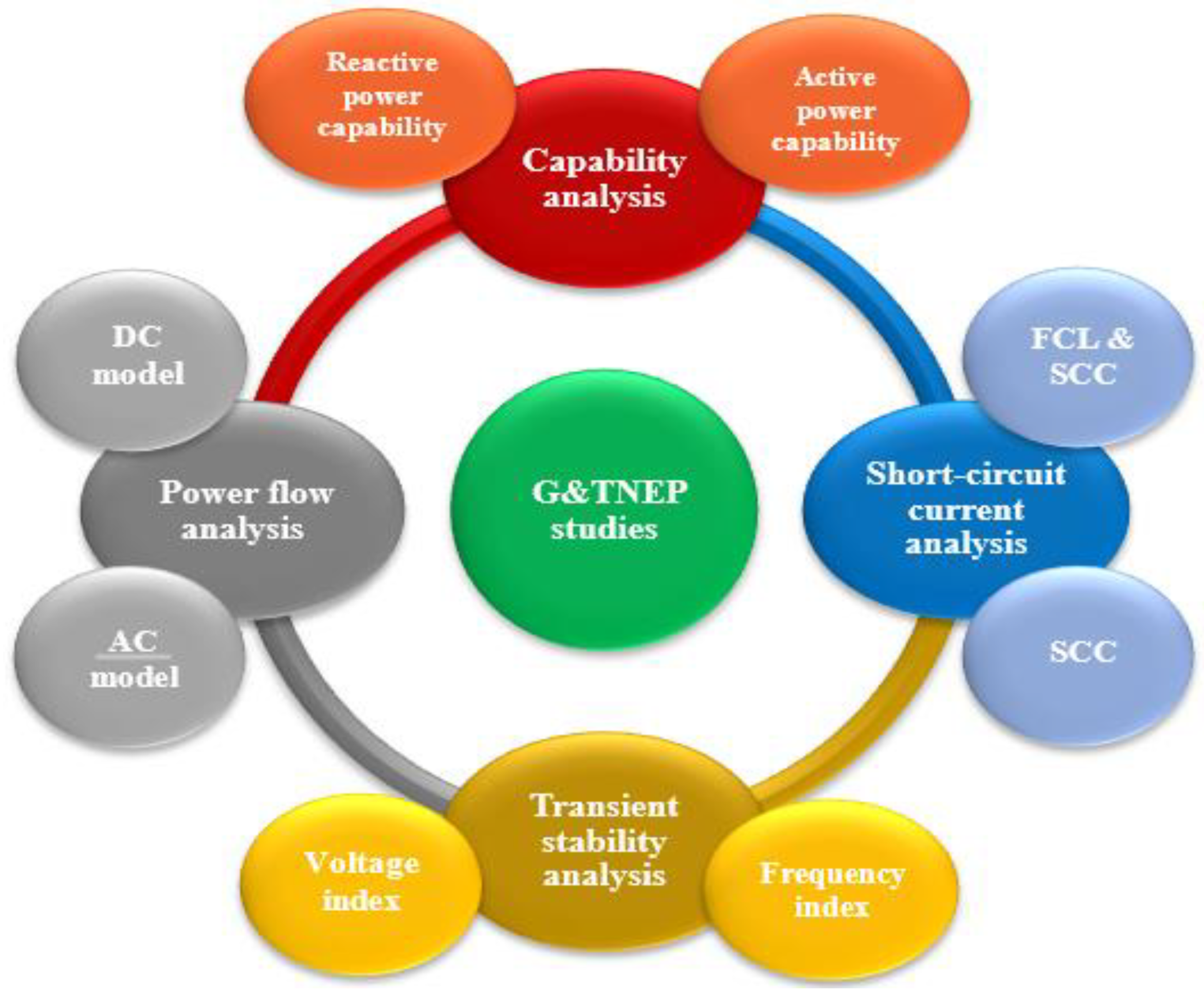
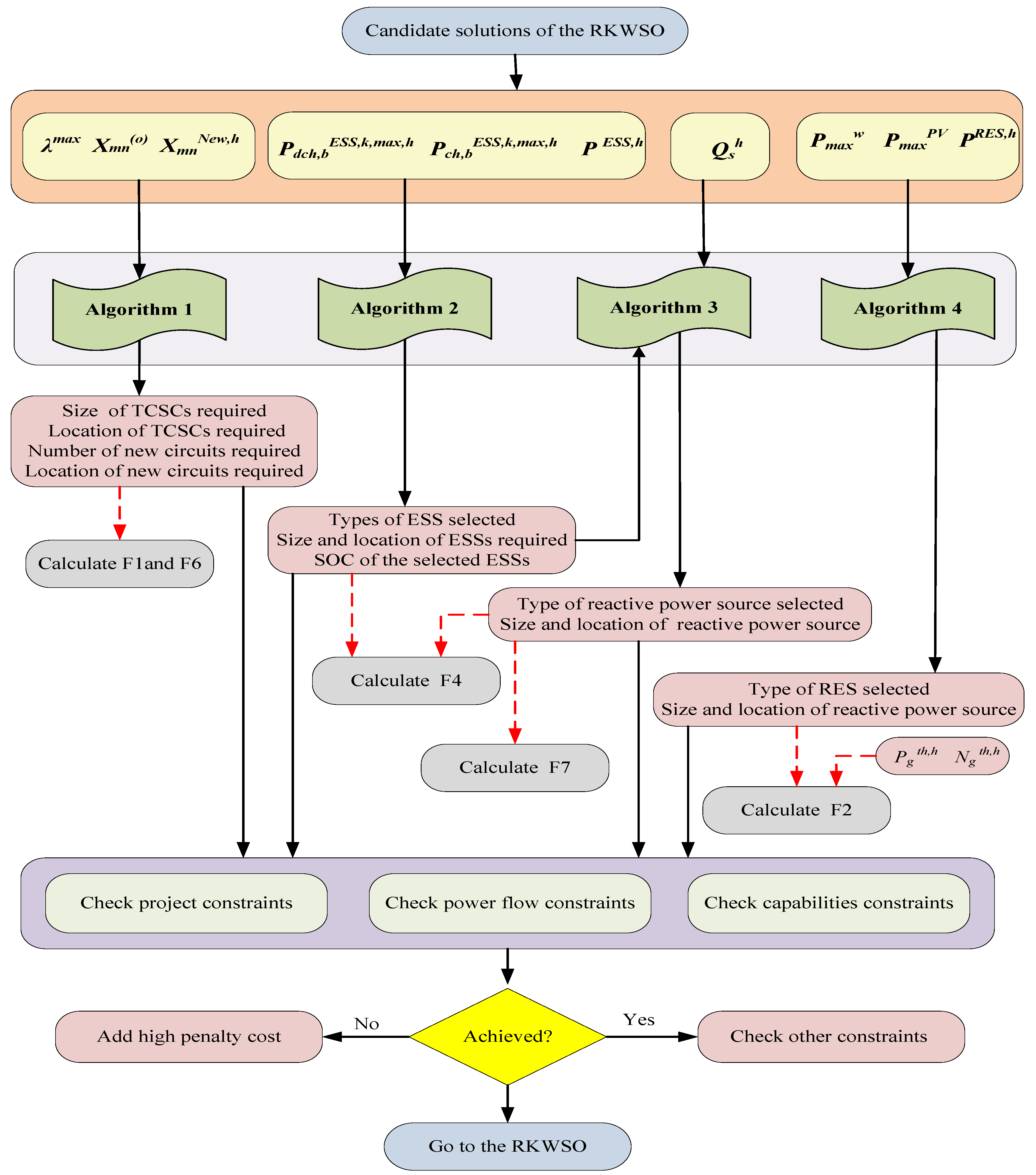
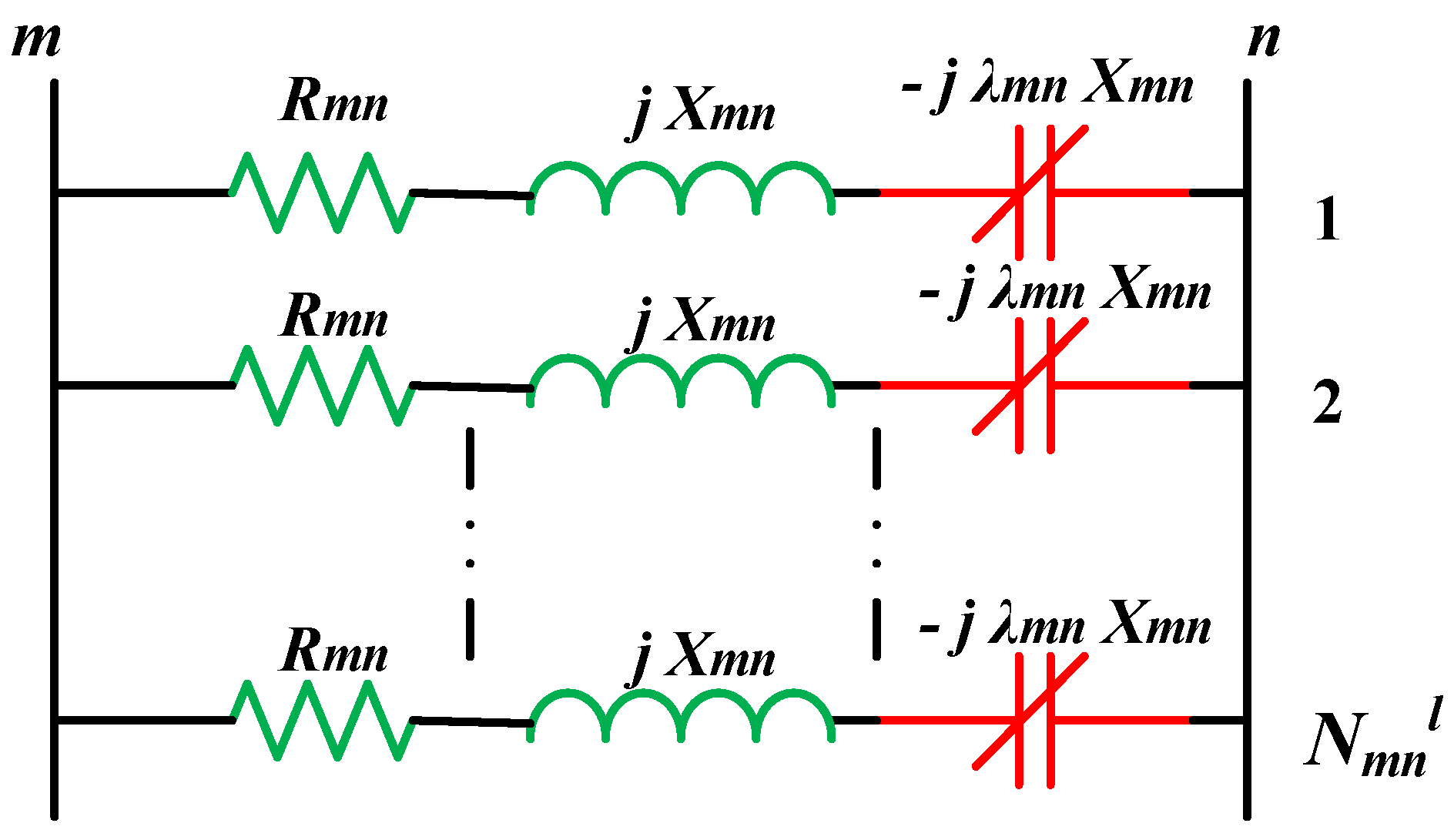
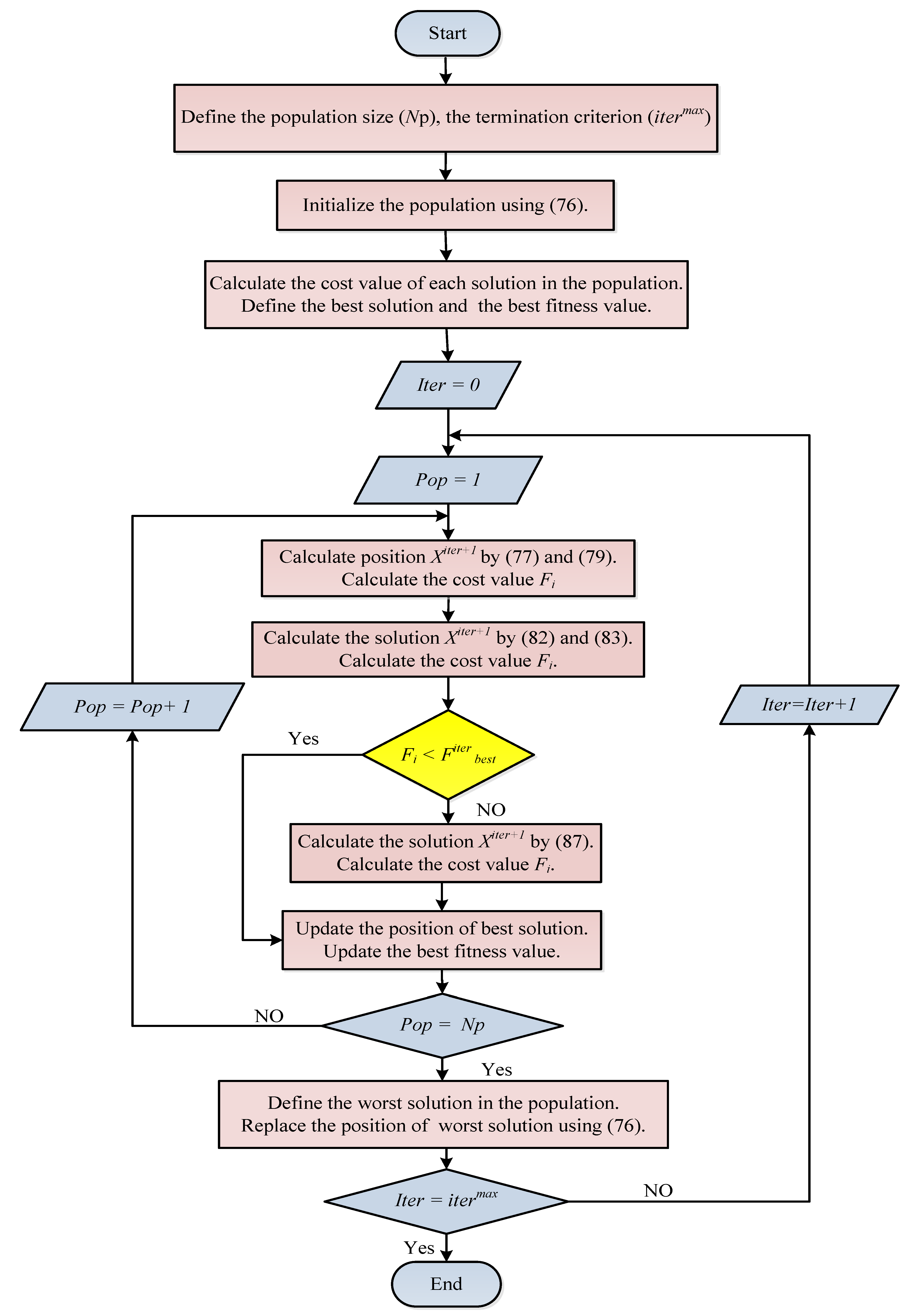
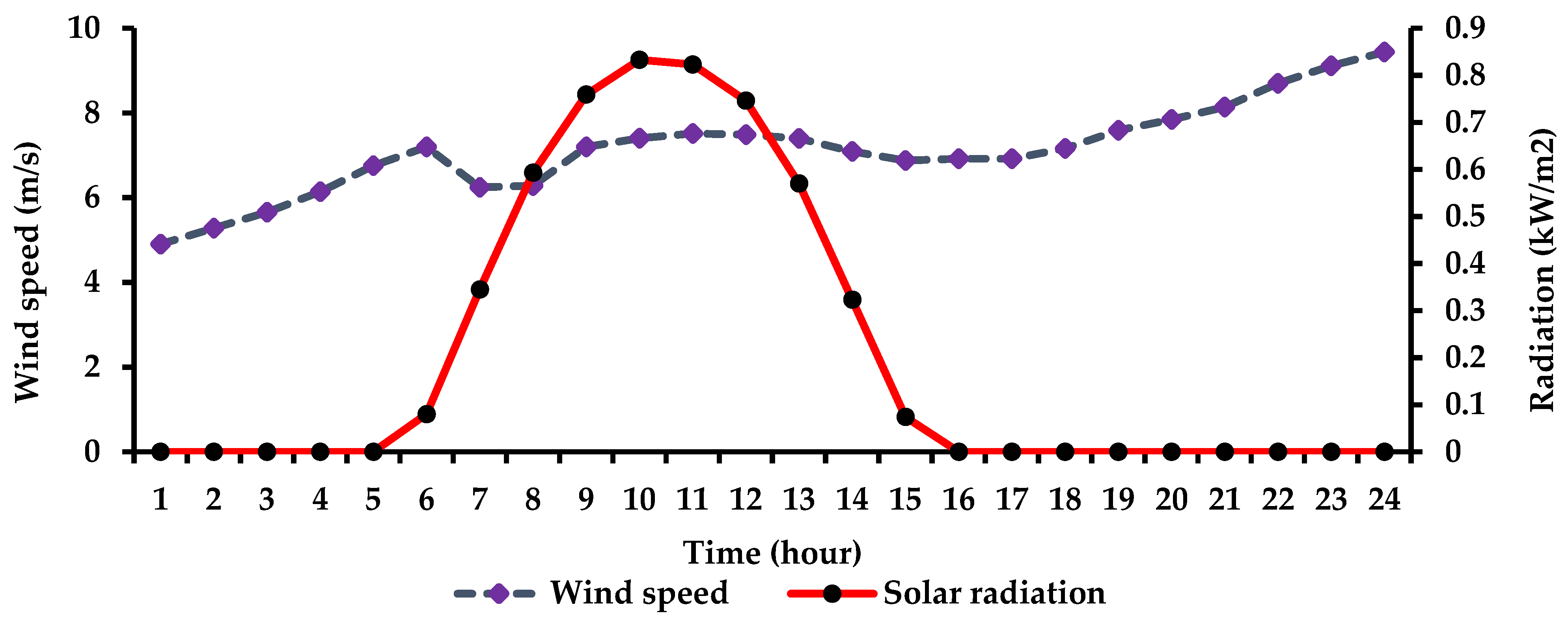
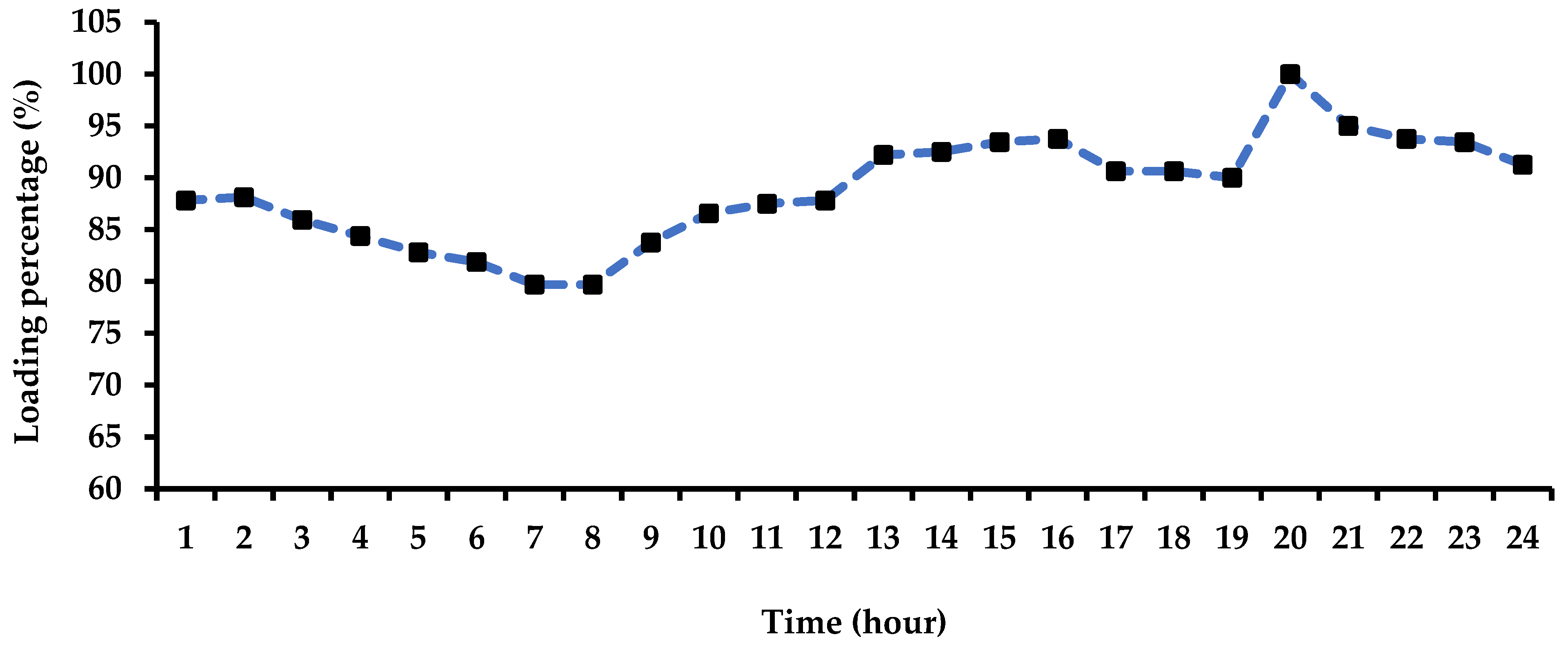
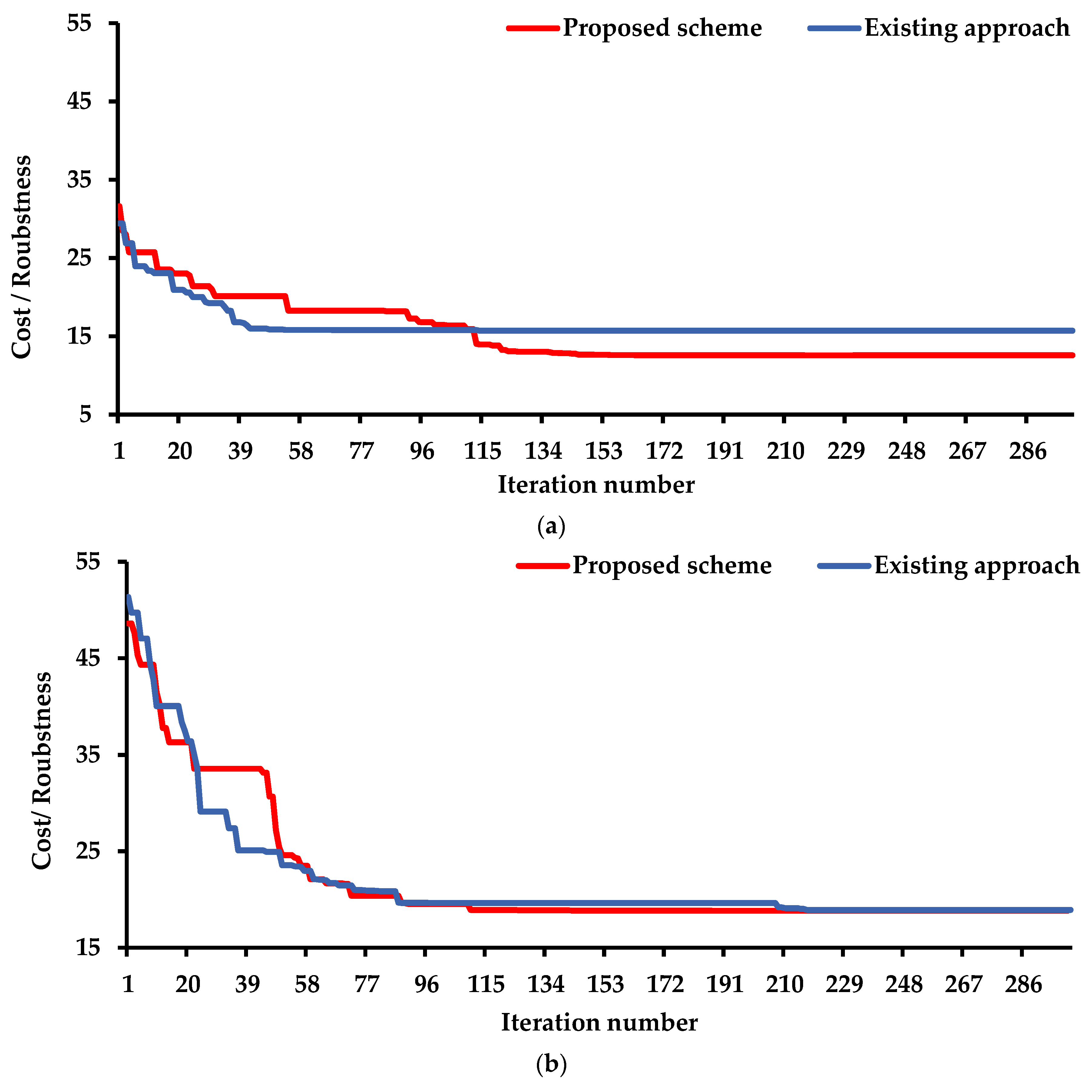



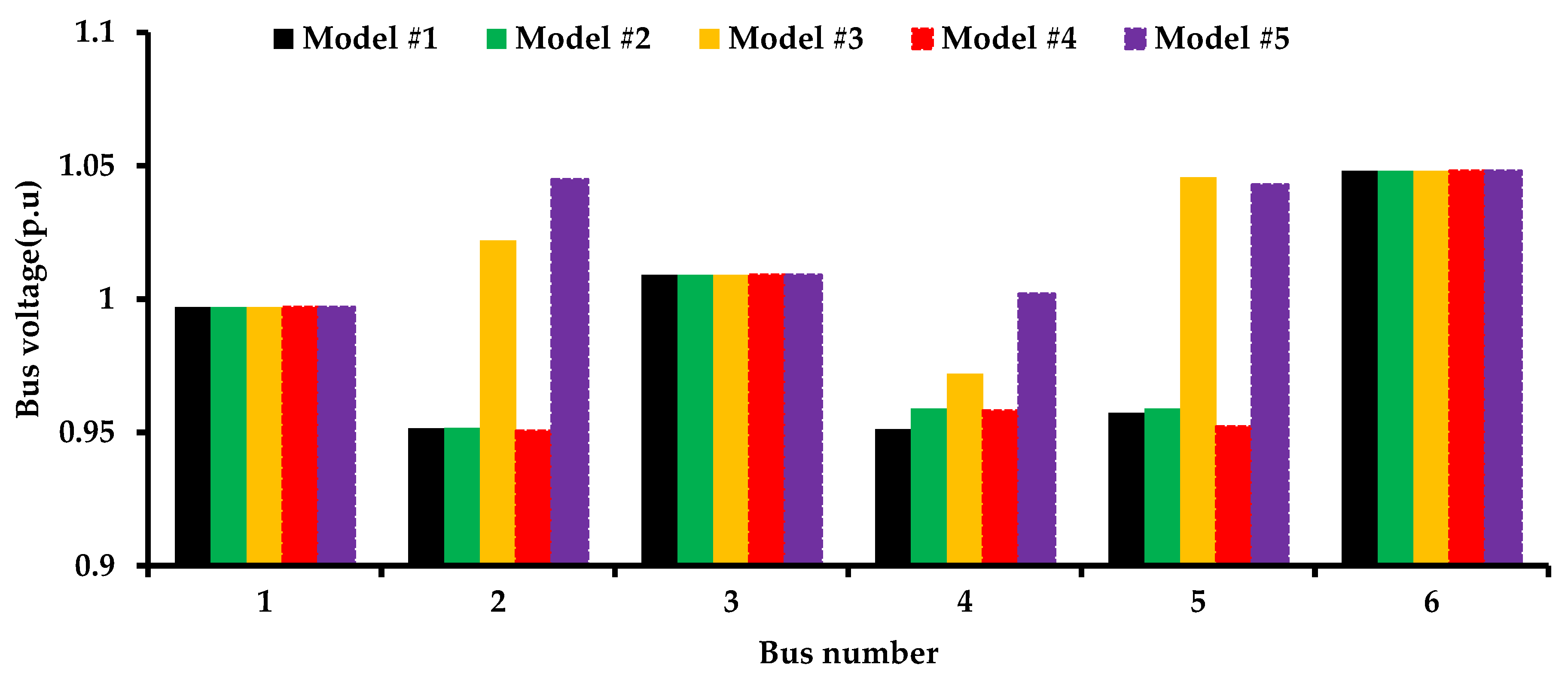
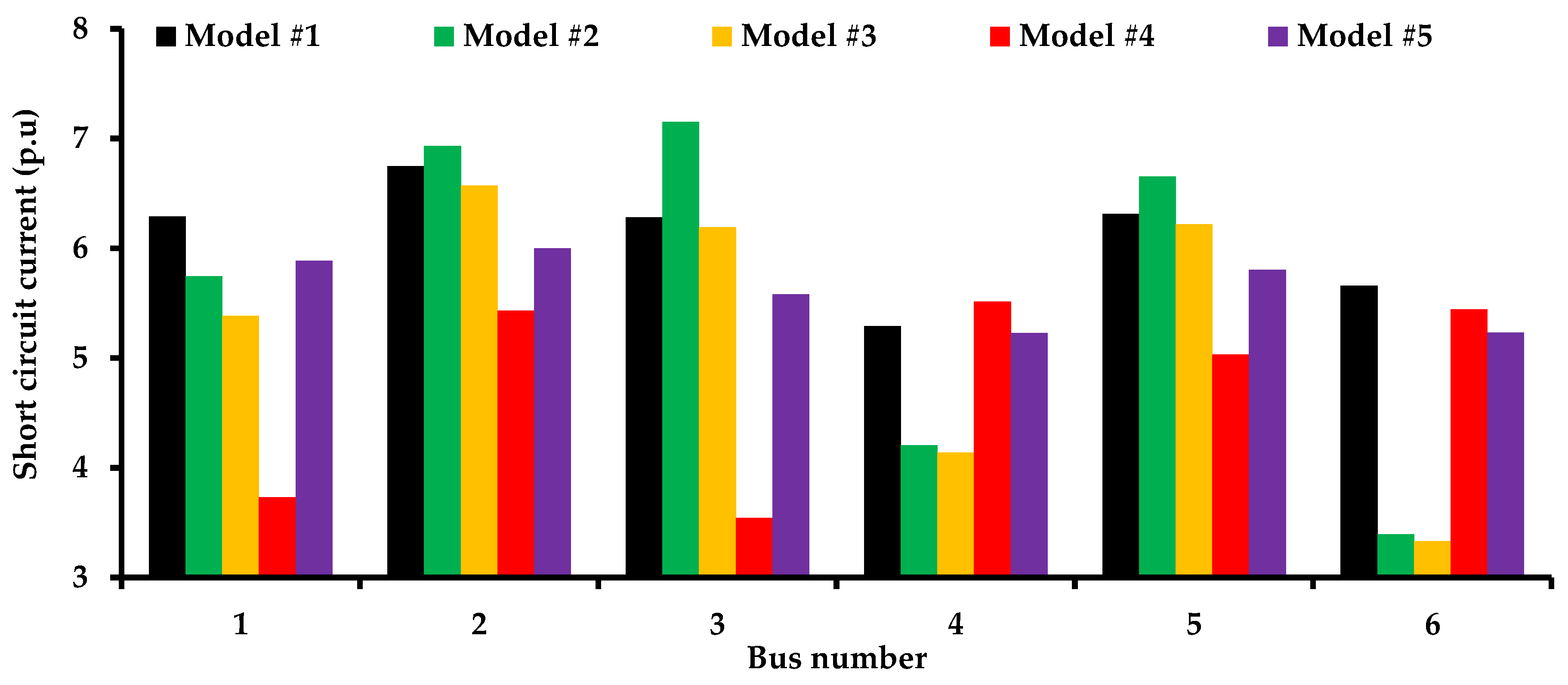
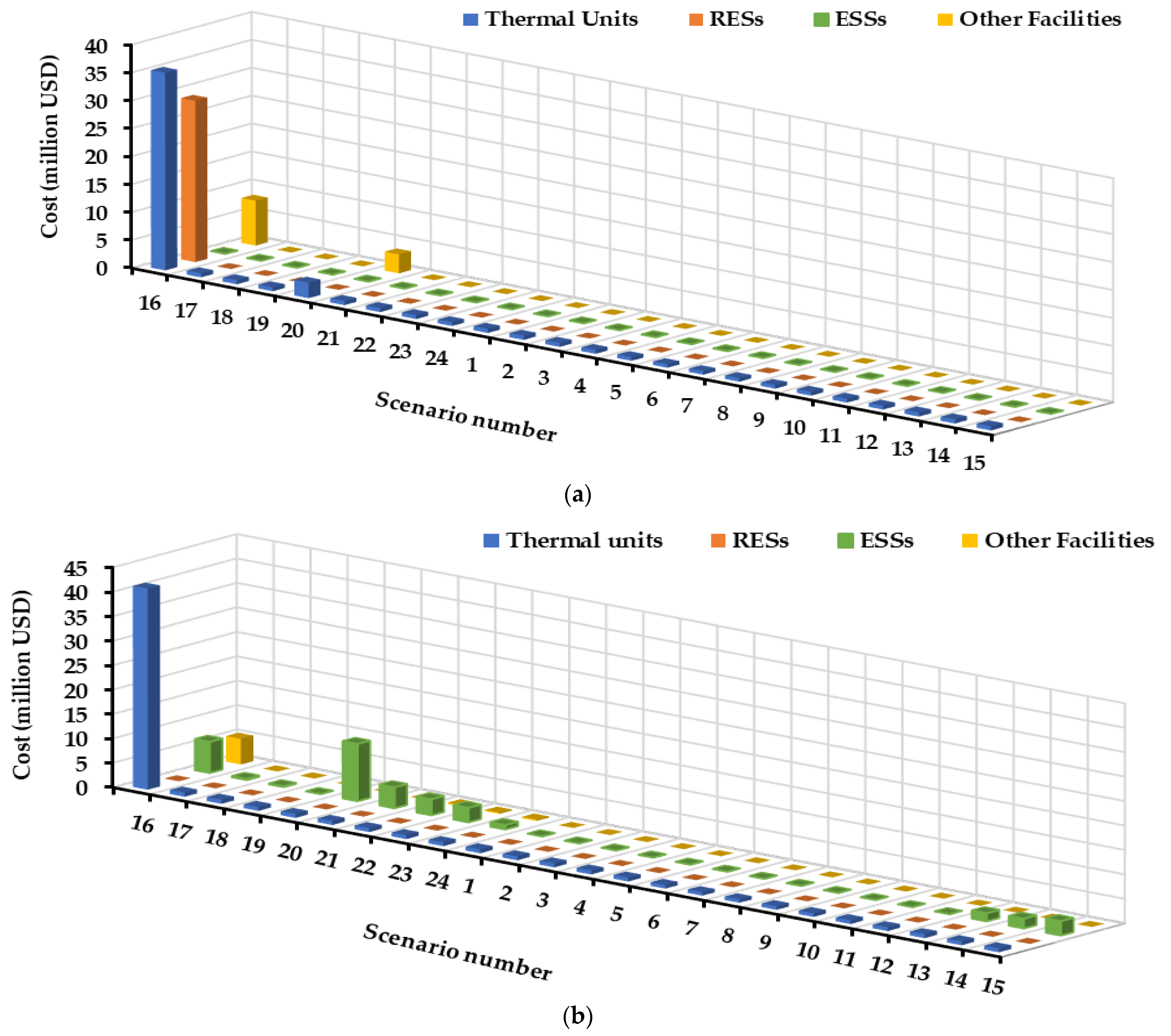
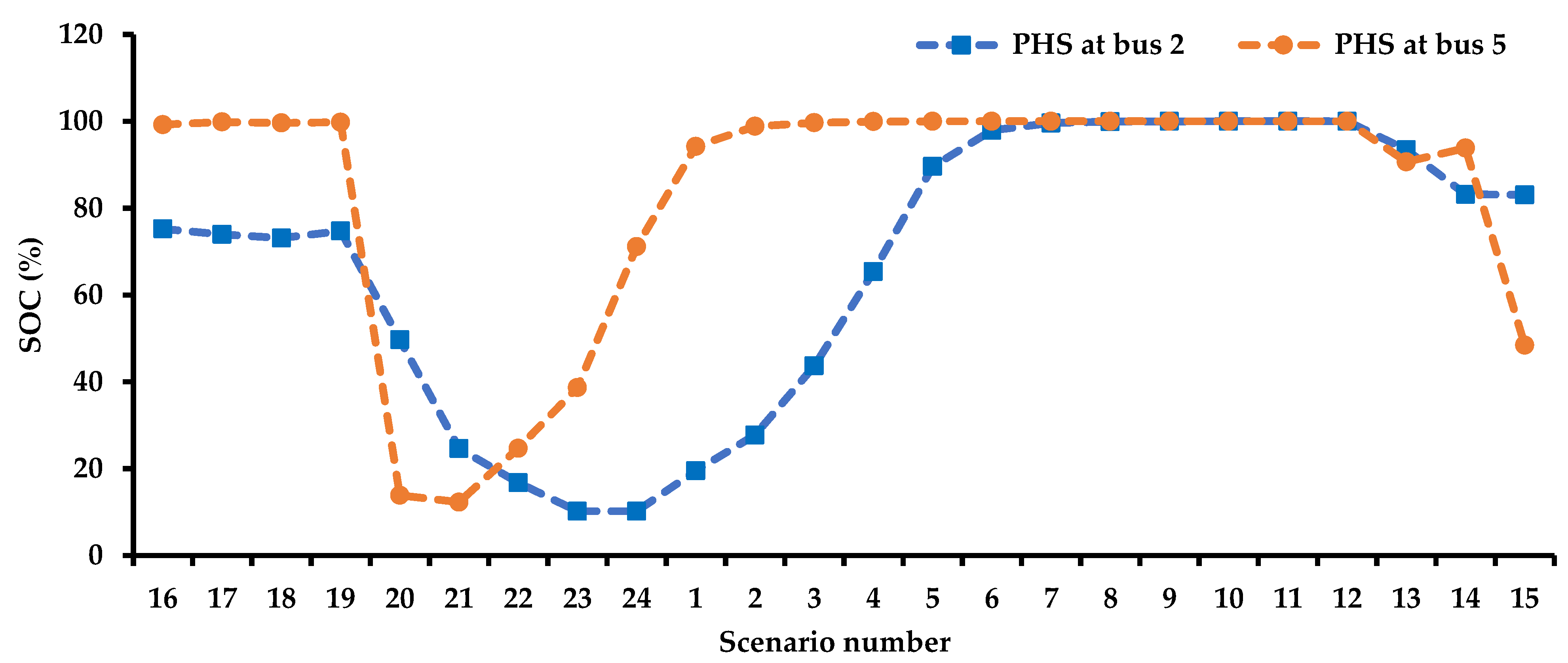
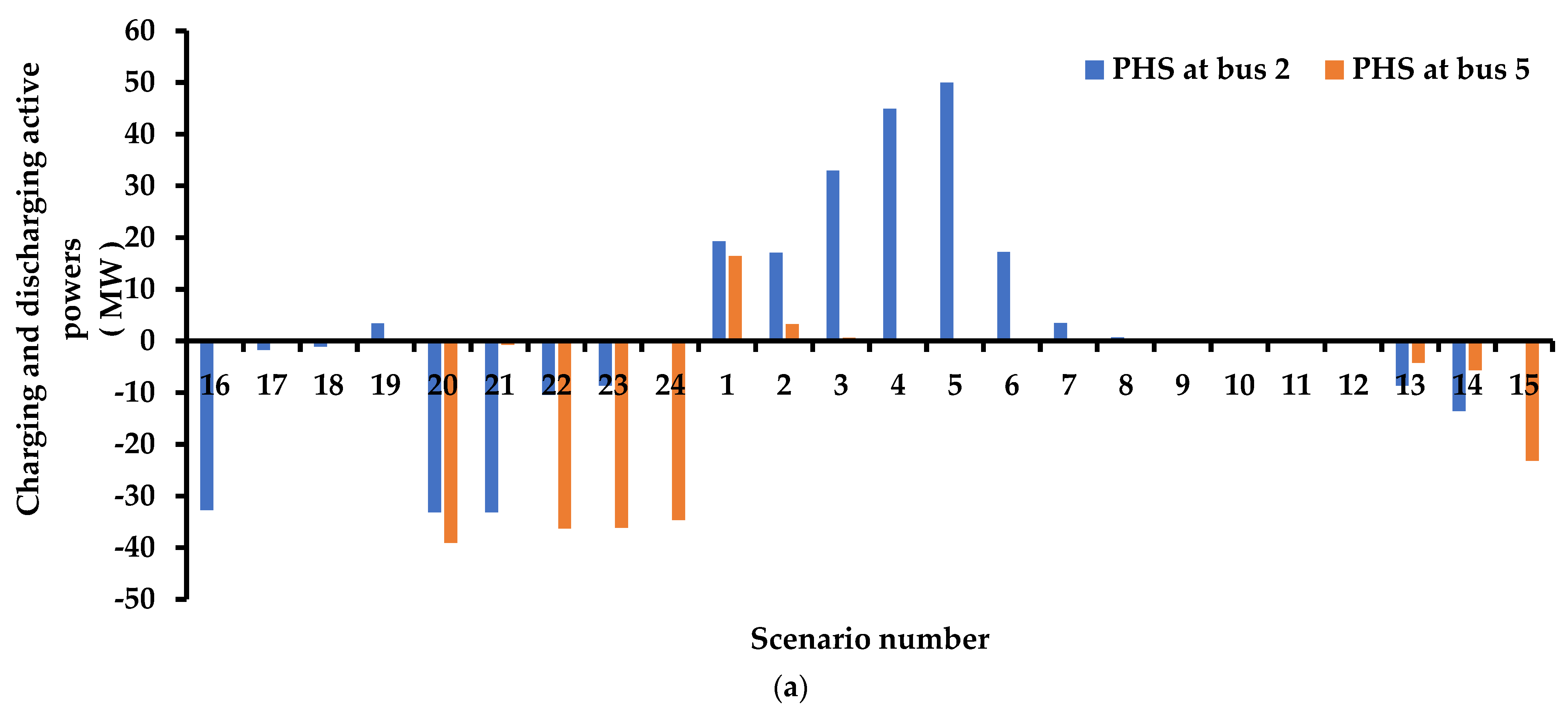
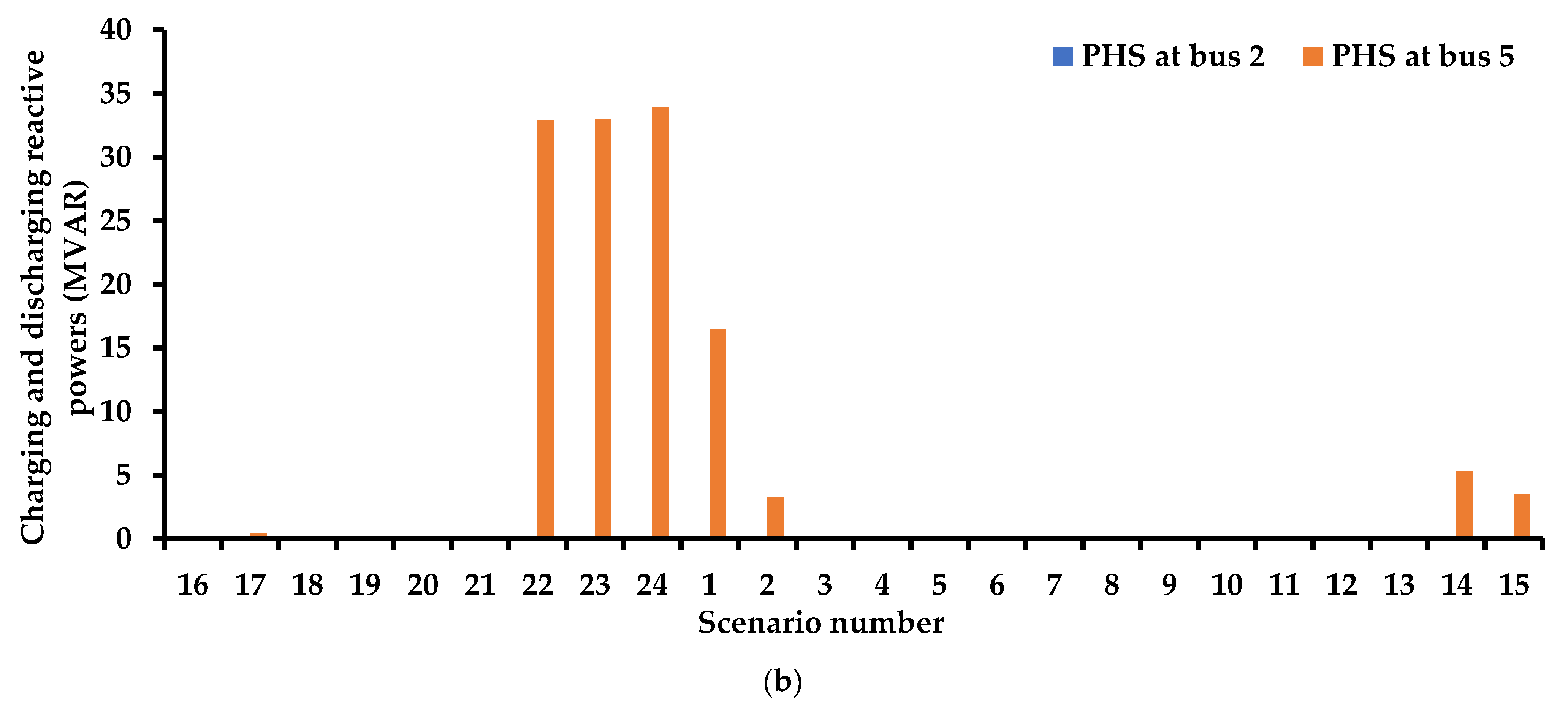
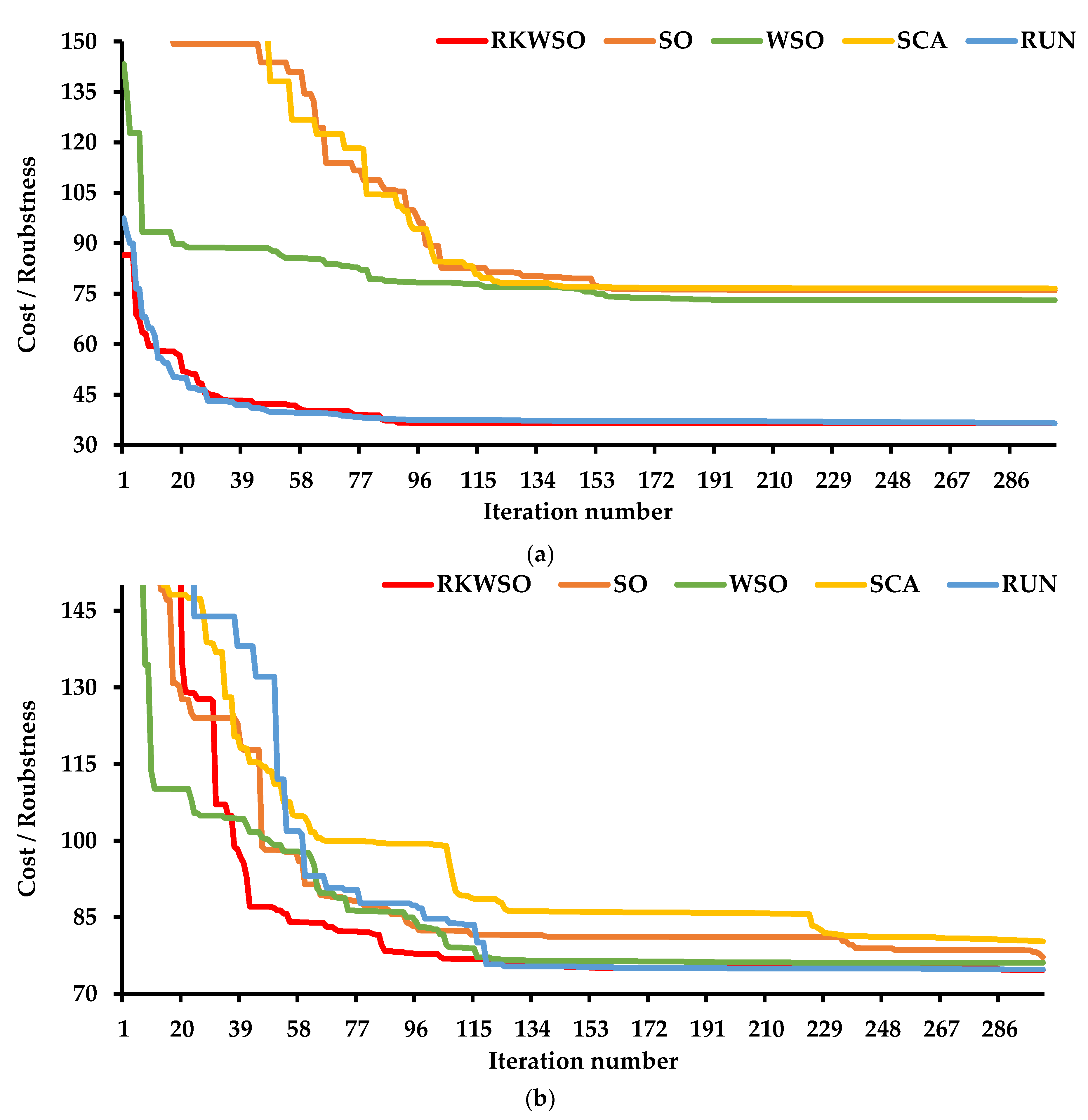
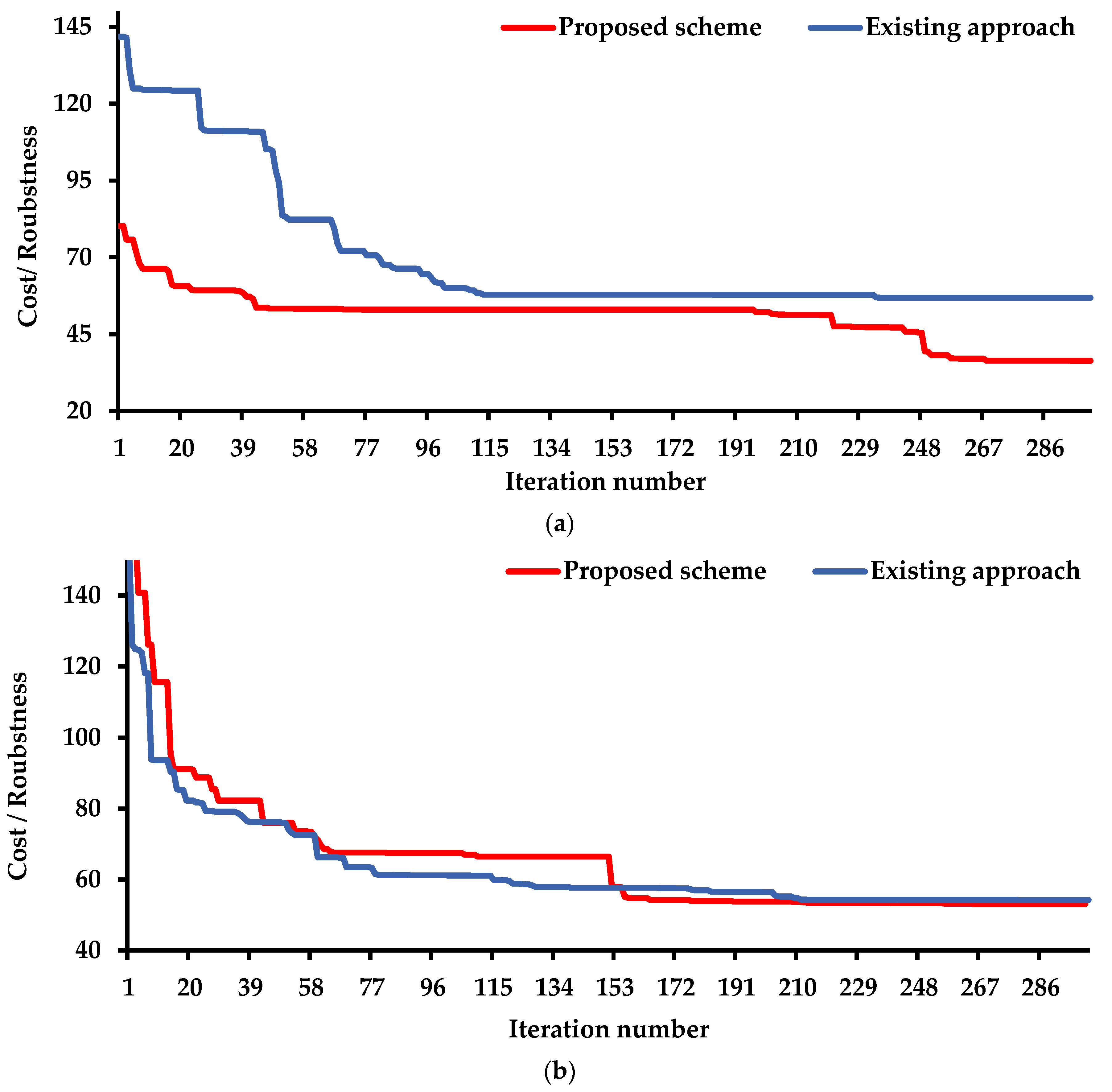
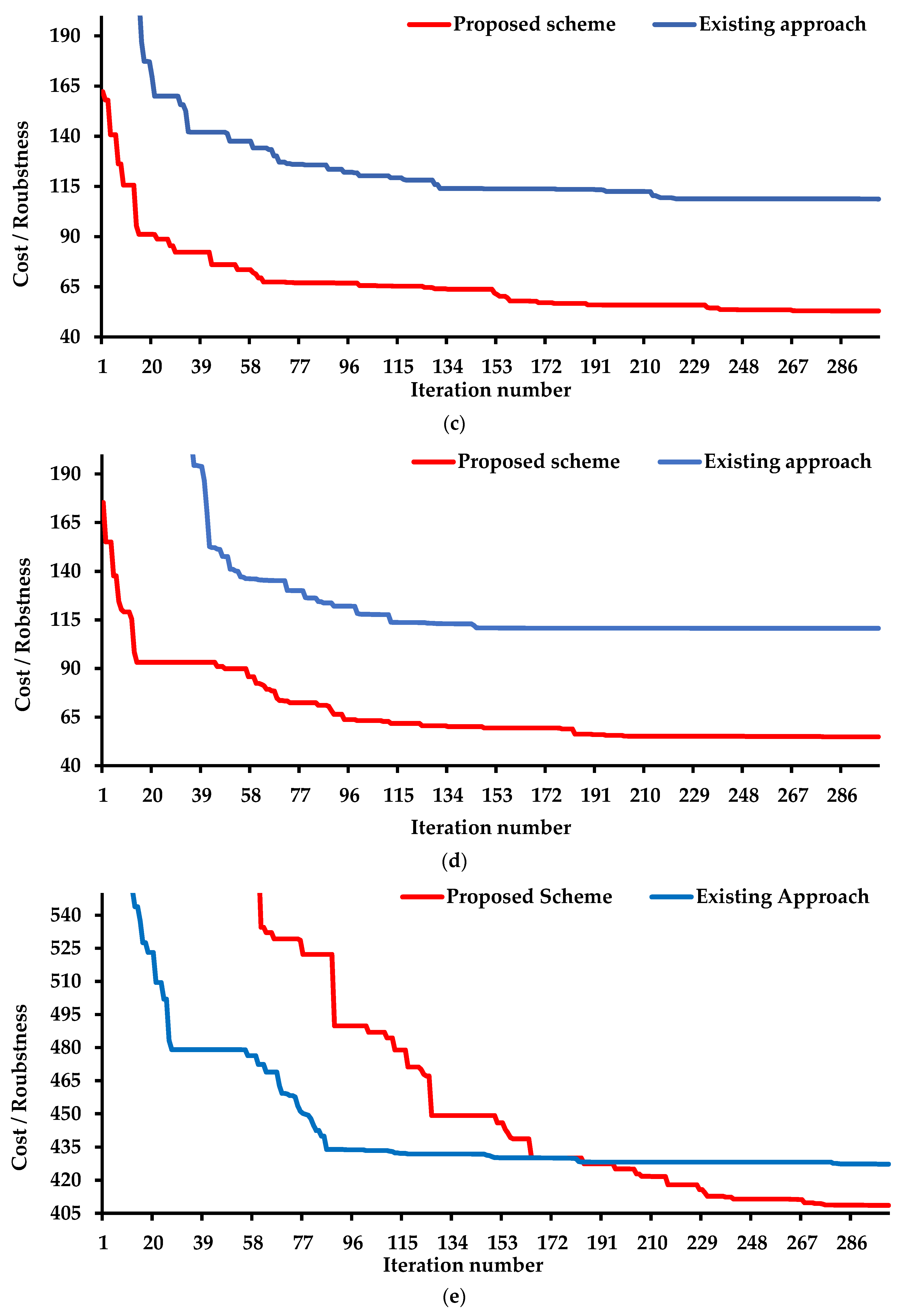
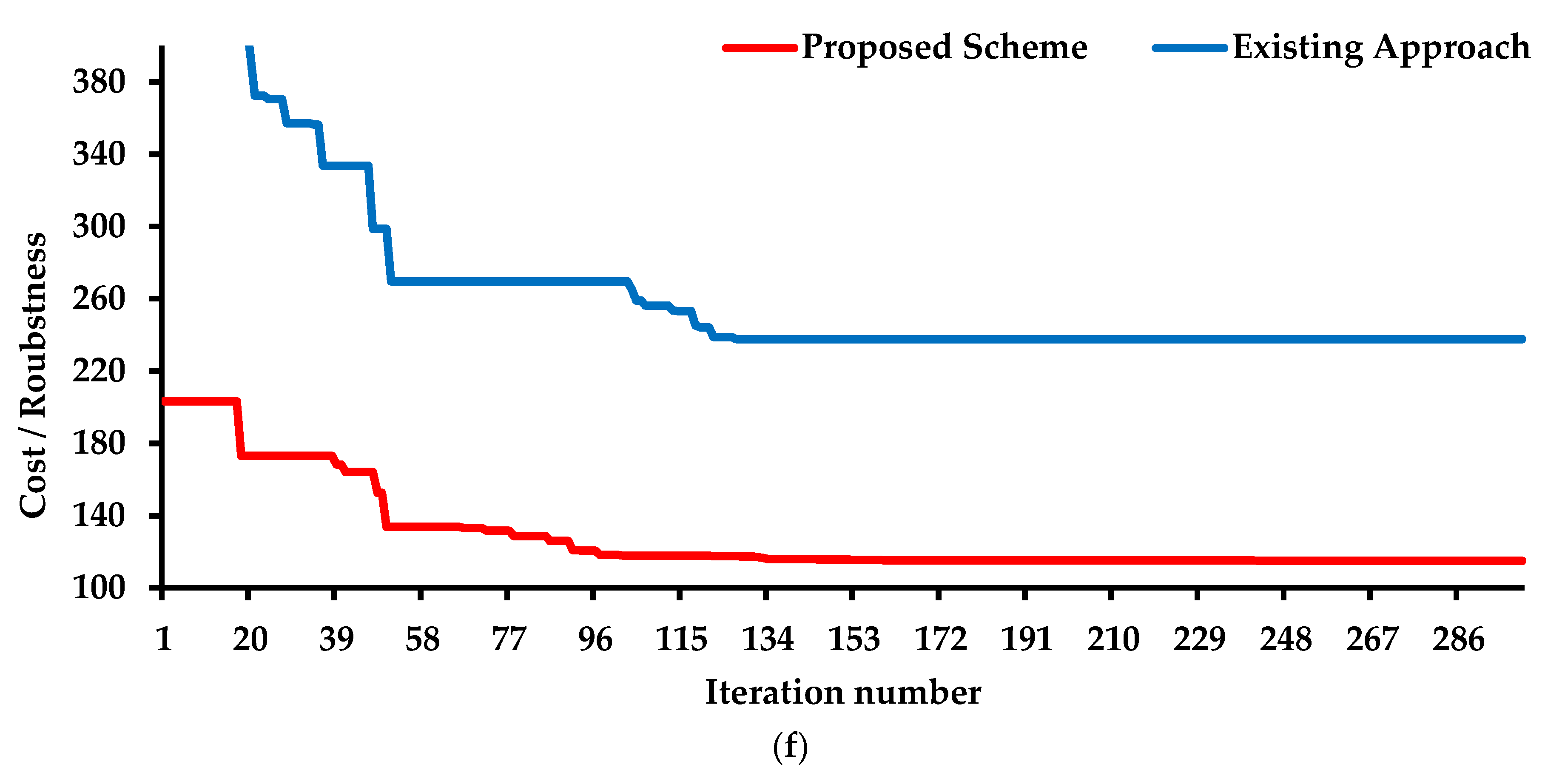
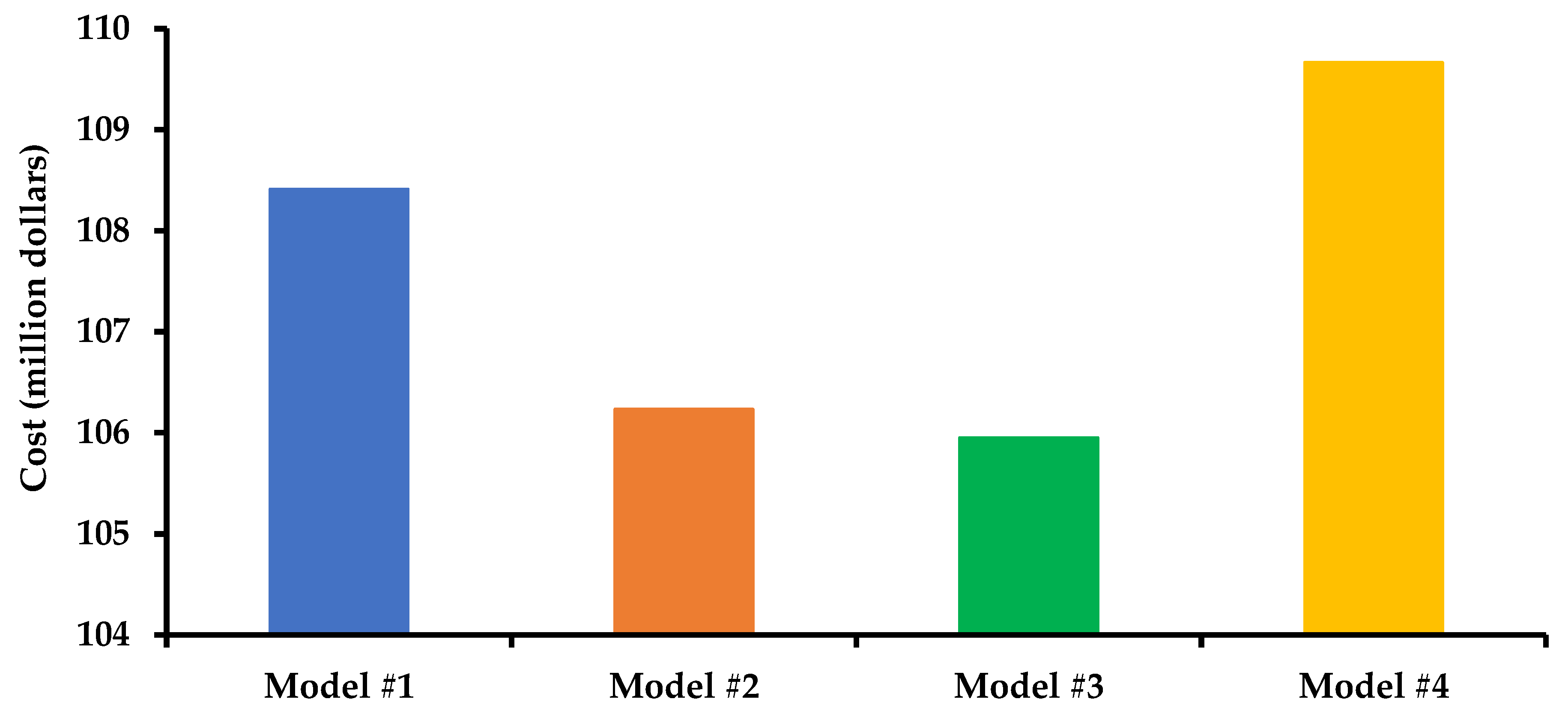
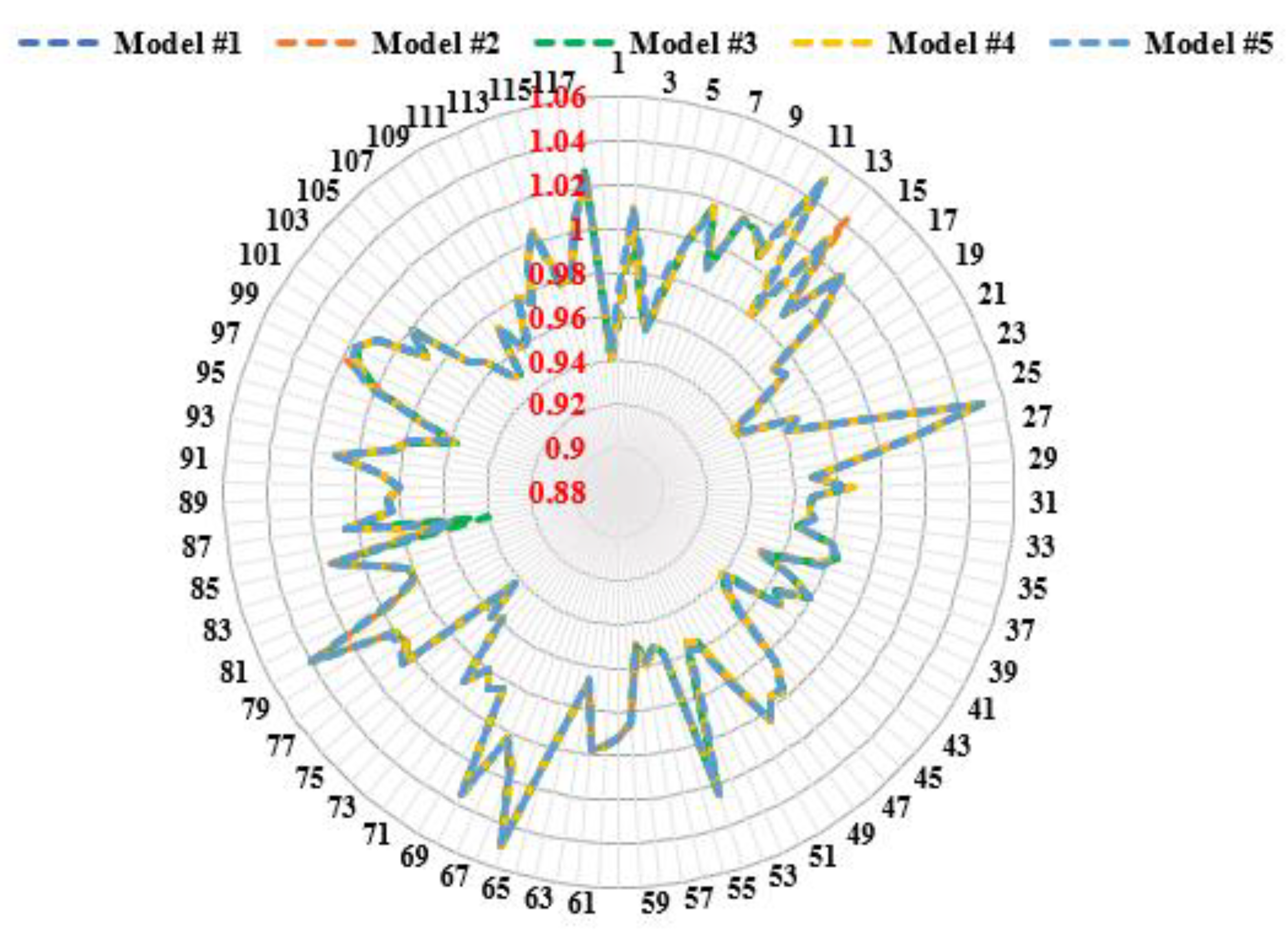
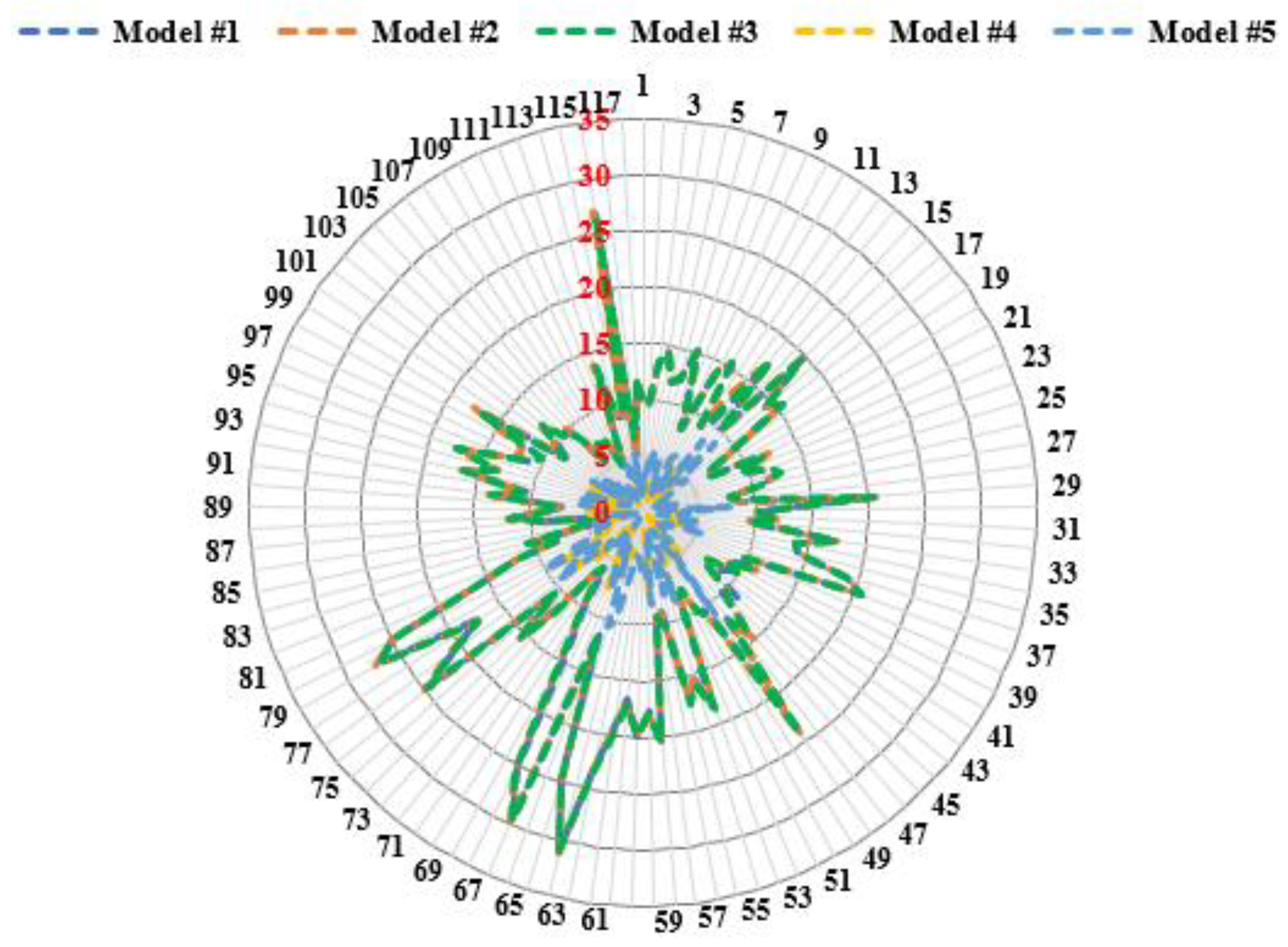
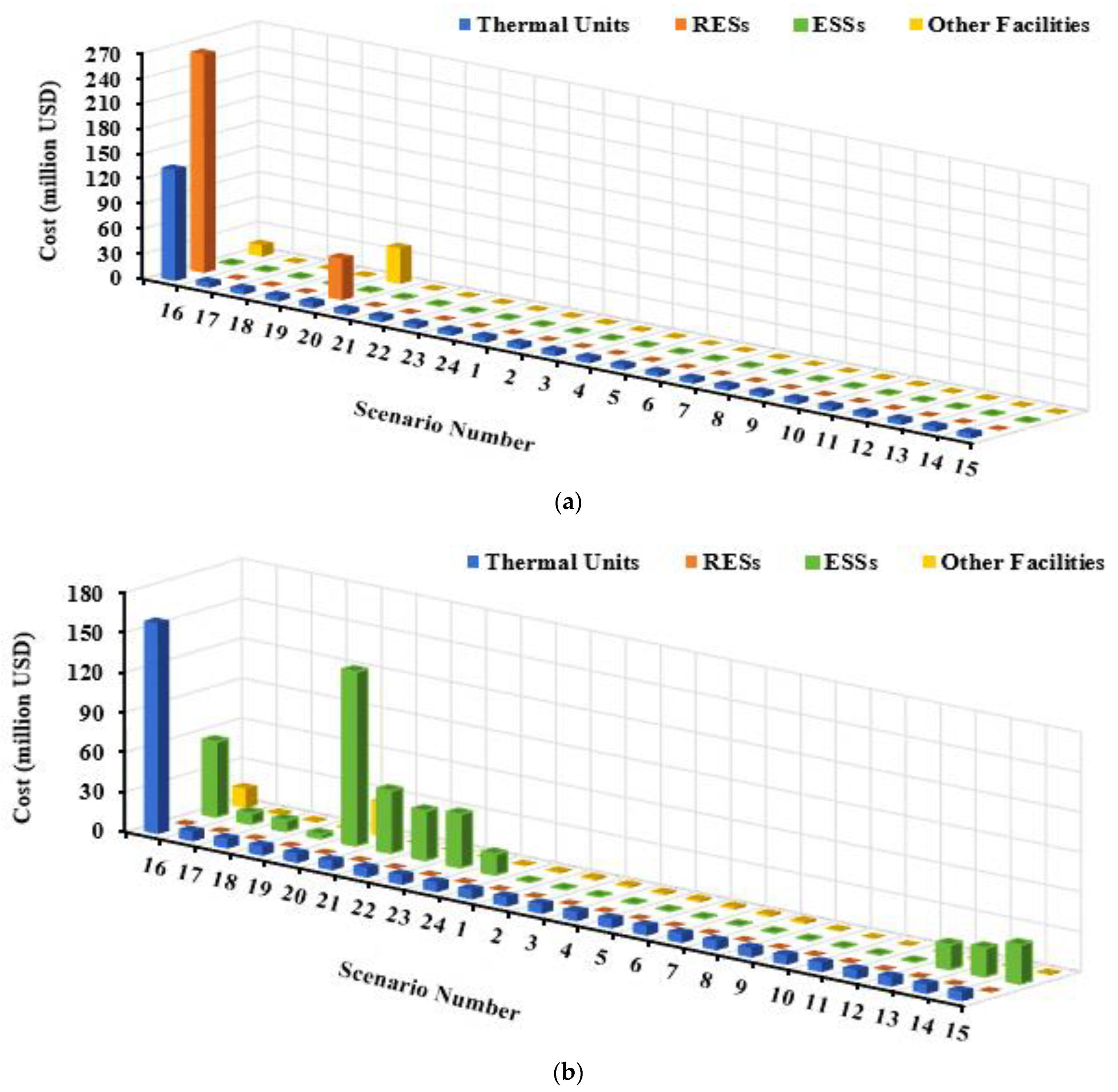
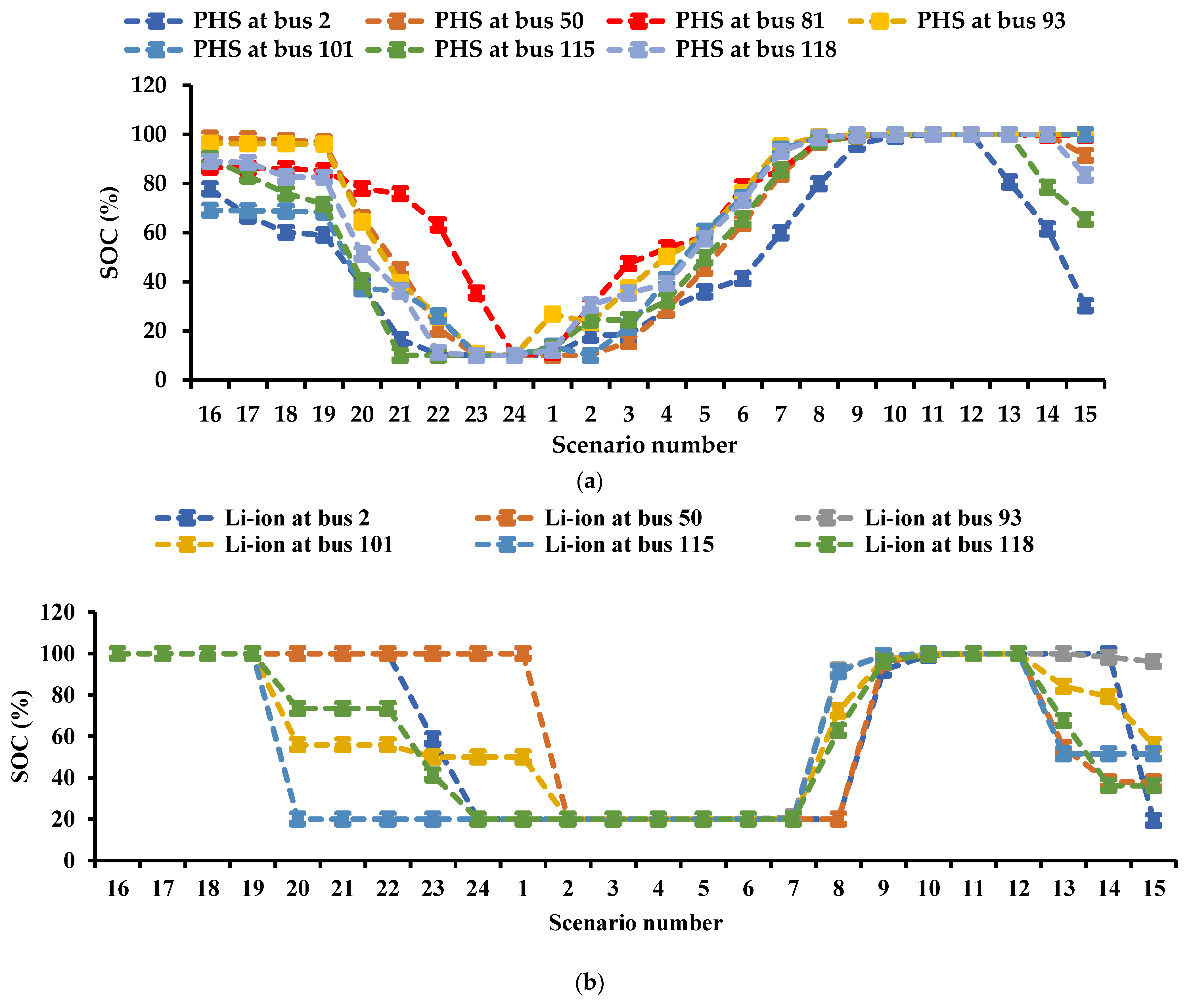
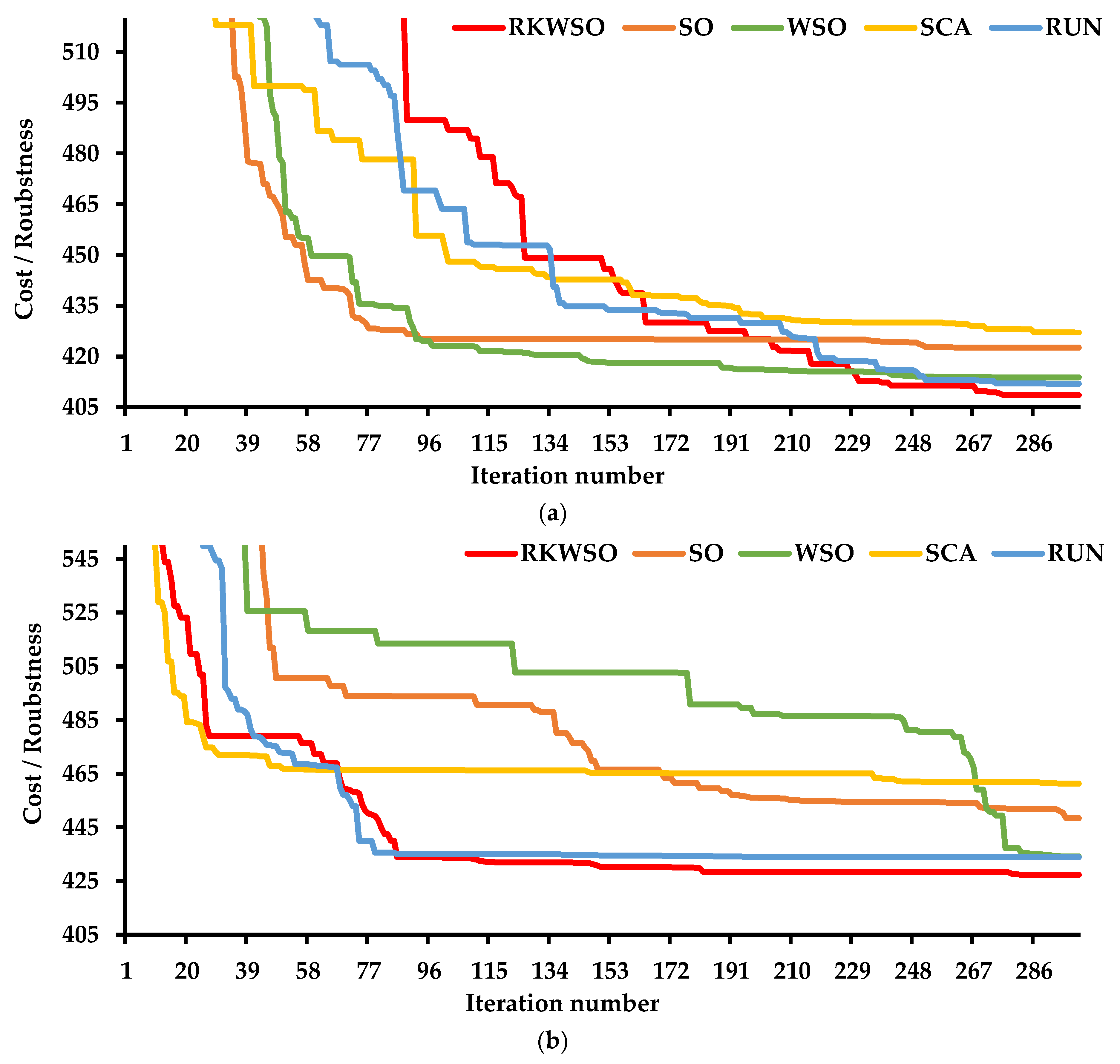
| Approach | Statistical Test | Model #1 | Model #2 | Model #3 | Model# 4 | Model# 5 (HCmin = 30%) | Model# 5 (HCmin = 0%) |
|---|---|---|---|---|---|---|---|
| Proposed Scheme | The best cost | 62.8137 | 56.5059 | 54.415 | 54.853 | 72.86 | 53.55 |
| The worst cost | 73.59 | 61.8192 | 66.543 | 65.084 | 80.23 | 60.86 | |
| Robustness | 5 | 3 | 3 | 2 | 2 | 2 | |
| T * (s) | 98.51 | 105.30 | 121.87 | 155.68 | 199.32 | 190.31 | |
| SD * | 2.19 | 1.585 | 3.05 | 3.26 | 2.12 | 1.94 | |
| Mean | 65.904 | 60.108 | 60.189 | 58.921 | 75.93 | 56.28 | |
| Existing Approach | The best cost | 62.8148 | 56.7619 | 54.655 | 55.873 | 74.62 | 57.62 |
| The worst cost | 76.136 | 66.9001 | 69.509 | 65.005 | 86.33 | 75.005 | |
| Robustness | 4 | 3 | 2 | 1 | 1 | 1 | |
| T (s) | 100.16 | 142.23 | 178.66 | 213.90 | 343.14 | 355.24 | |
| SD | 2.65 | 2.67 | 3.218 | 3.68 | 3.41 | 4.18 | |
| Mean | 68.494 | 60.838 | 60.809 | 59.997 | 81.16 | 62.97 |
| Approach | Statistical Test | RKWSO | SO | WSO | SCA | RUN |
|---|---|---|---|---|---|---|
| Proposed scheme | The best cost | 72.86 | 75.97 | 73.06 | 76.54 | 73.30 |
| The worst cost | 80.23 | 97.58 | 86.94 | 102.22 | 84.31 | |
| Robustness | 2 | 1 | 1 | 1 | 2 | |
| T (s) | 199.32 | 183.34 | 115.52 | 142.52 | 328.78 | |
| SD | 2.12 | 4.51 | 3.504 | 5.11 | 3.12 | |
| Mean | 75.93 | 81.91 | 78.41 | 88.53 | 77.58 | |
| Existing approach | The best cost | 74.62 | 77.18 | 76.07 | 80.23 | 74.73 |
| The worst cost | 86.33 | 98.70 | 90.14 | 104.61 | 90.65 | |
| Robustness | 1 | 1 | 1 | 1 | 1 | |
| T (s) | 343.14 | 276.23 | 246.33 | 270.02 | 501.87 | |
| SD | 3.41 | 5.42 | 3.71 | 6.85 | 3.22 | |
| Mean | 81.16 | 84.6 | 83.04 | 95.51 | 82.49 |
| Approach | Statistical Test | Model #1 | Model #2 | Model #3 | Model #4 | Model #5 (HCmin = 30%) | Model #5 (HCmin = 0%) |
|---|---|---|---|---|---|---|---|
| Proposed scheme | The best cost | 108.411 | 106.2339 | 105.952 | 109.665 | 408.57 | 229.99 |
| The worst cost | 117.518 | 113.973 | 118.76 | 120.095 | 417.23 | 248.917 | |
| Robustness | 3 | 2 | 2 | 2 | 1 | 2 | |
| T (s) | 703.24 | 732.2 | 768.18 | 840.02 | 2409.56 | 2398.38 | |
| SD | 2.17 | 2.305 | 3.863 | 3.602 | 2.855 | 5.034 | |
| Mean | 112.2201 | 109.645 | 110.436 | 116.571 | 413.478 | 235.67 | |
| Existing approach | The best cost | 108.629 | 108.435 | 108.697 | 110.697 | 427.27 | 237.69 |
| The worst cost | 124.249 | 113.862 | 120.453 | 130.192 | 443.79 | 267.023 | |
| Robustness | 2 | 2 | 1 | 1 | 1 | 1 | |
| T (s) | 811.22 | 851.41 | 907.05 | 1104.10 | 2904.87 | 2969.51 | |
| SD | 2.64 | 2.424 | 4.123 | 7.606 | 4.0225 | 10.401 | |
| Mean | 118.832 | 110.462 | 115.6895 | 119.253 | 433.224 | 248.14 |
| Approach | Statistical Test | RKWSO | SO | WSO | SCA | RUN |
|---|---|---|---|---|---|---|
| Proposed scheme | The best cost | 408.57 | 422.62 | 413.81 | 427.06 | 411.94 |
| The worst cost | 417.23 | 450.53 | 448.31 | 462.32 | 422.41 | |
| Robustness | 1 | 1 | 1 | 1 | 1 | |
| T (s) | 2409.56 | 2343.55 | 2244.39 | 2200.93 | 2785.71 | |
| SD | 2.855 | 5.651 | 9.349 | 10.76 | 3.152 | |
| Mean | 413.478 | 432.827 | 429.335 | 445.234 | 417.14 | |
| Existing approach | The best cost | 427.27 | 448.42 | 443.17 | 461.33 | 433.85 |
| The worst cost | 443.79 | 469.254 | 462.024 | 486.78 | 448.230 | |
| Robustness | 1 | 1 | 1 | 1 | 1 | |
| T (s) | 2904.87 | 2851.11 | 2765.02 | 2723,91 | 3147.33 | |
| SD | 4.0225 | 7.21 | 6.49 | 6.213 | 4.2814 | |
| Mean | 433.224 | 456.526 | 452.051 | 473.847 | 439.908 |
Disclaimer/Publisher’s Note: The statements, opinions and data contained in all publications are solely those of the individual author(s) and contributor(s) and not of MDPI and/or the editor(s). MDPI and/or the editor(s) disclaim responsibility for any injury to people or property resulting from any ideas, methods, instructions or products referred to in the content. |
© 2023 by the authors. Licensee MDPI, Basel, Switzerland. This article is an open access article distributed under the terms and conditions of the Creative Commons Attribution (CC BY) license (https://creativecommons.org/licenses/by/4.0/).
Share and Cite
Refaat, M.M.; Aleem, S.H.E.A.; Atia, Y.; Zahab, E.E.D.A.; Sayed, M.M. A New Decision-Making Strategy for Techno-Economic Assessment of Generation and Transmission Expansion Planning for Modern Power Systems. Systems 2023, 11, 23. https://doi.org/10.3390/systems11010023
Refaat MM, Aleem SHEA, Atia Y, Zahab EEDA, Sayed MM. A New Decision-Making Strategy for Techno-Economic Assessment of Generation and Transmission Expansion Planning for Modern Power Systems. Systems. 2023; 11(1):23. https://doi.org/10.3390/systems11010023
Chicago/Turabian StyleRefaat, Mohamed M., Shady H. E. Abdel Aleem, Yousry Atia, Essam El Din Aboul Zahab, and Mahmoud M. Sayed. 2023. "A New Decision-Making Strategy for Techno-Economic Assessment of Generation and Transmission Expansion Planning for Modern Power Systems" Systems 11, no. 1: 23. https://doi.org/10.3390/systems11010023
APA StyleRefaat, M. M., Aleem, S. H. E. A., Atia, Y., Zahab, E. E. D. A., & Sayed, M. M. (2023). A New Decision-Making Strategy for Techno-Economic Assessment of Generation and Transmission Expansion Planning for Modern Power Systems. Systems, 11(1), 23. https://doi.org/10.3390/systems11010023







